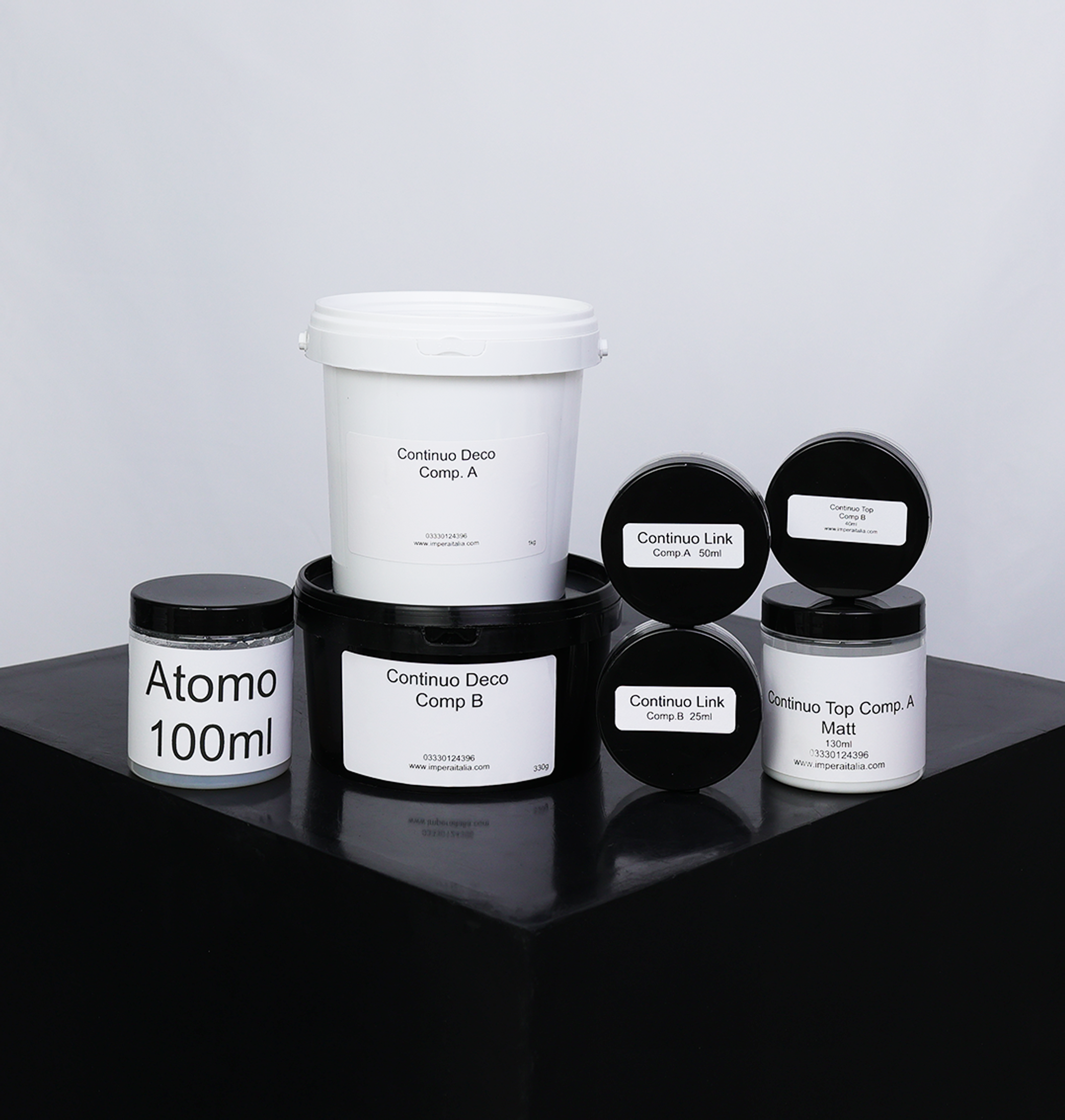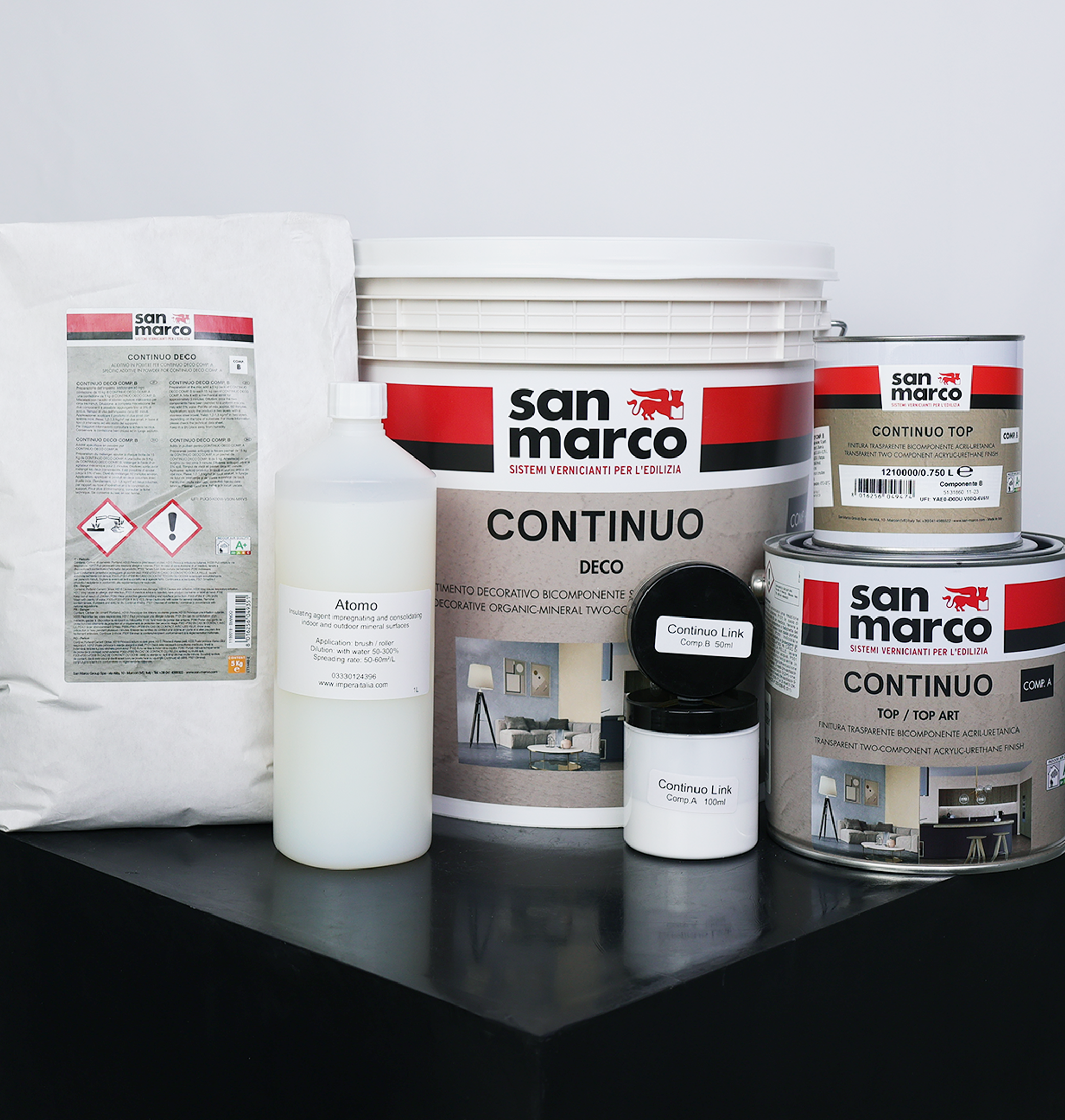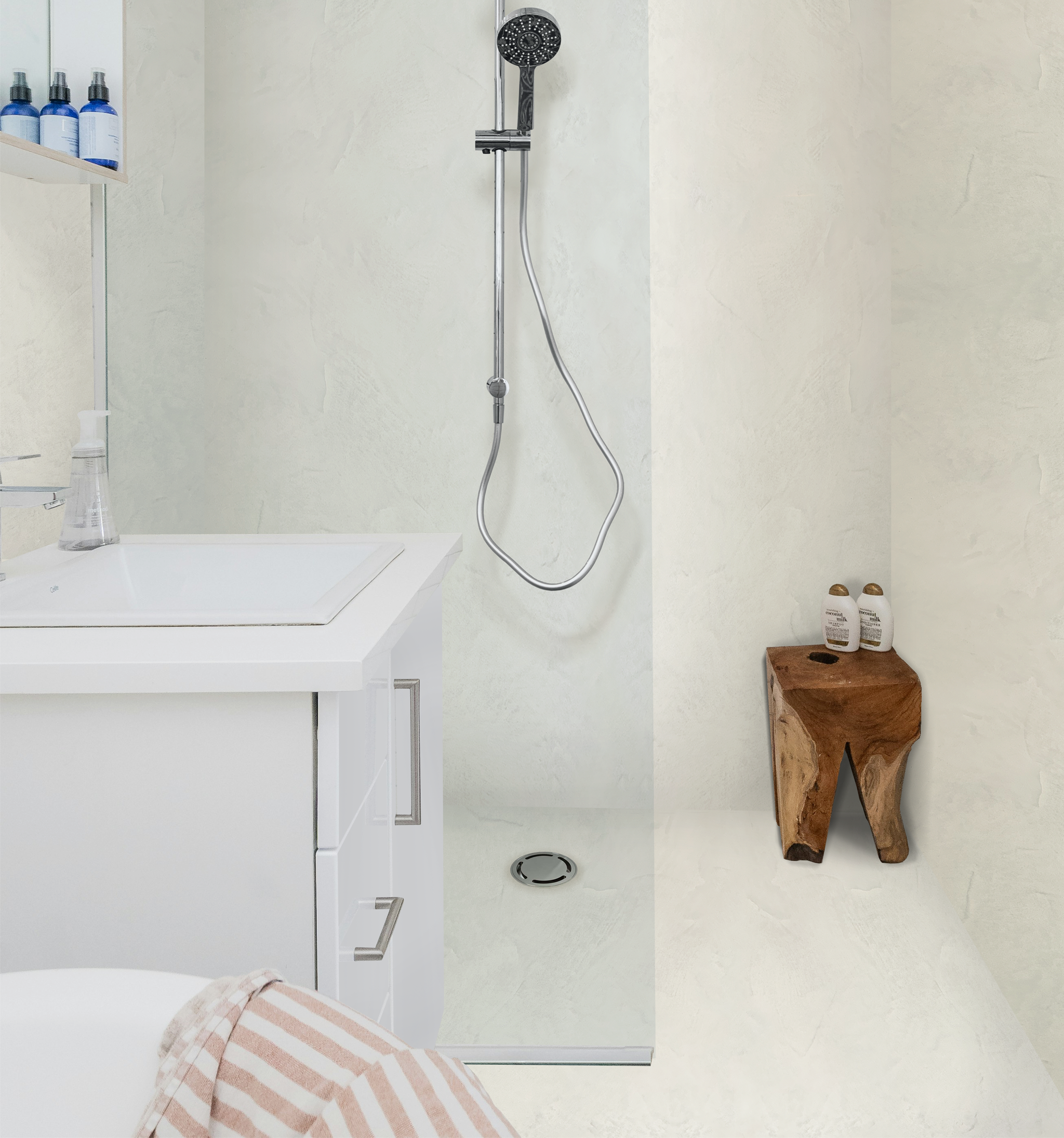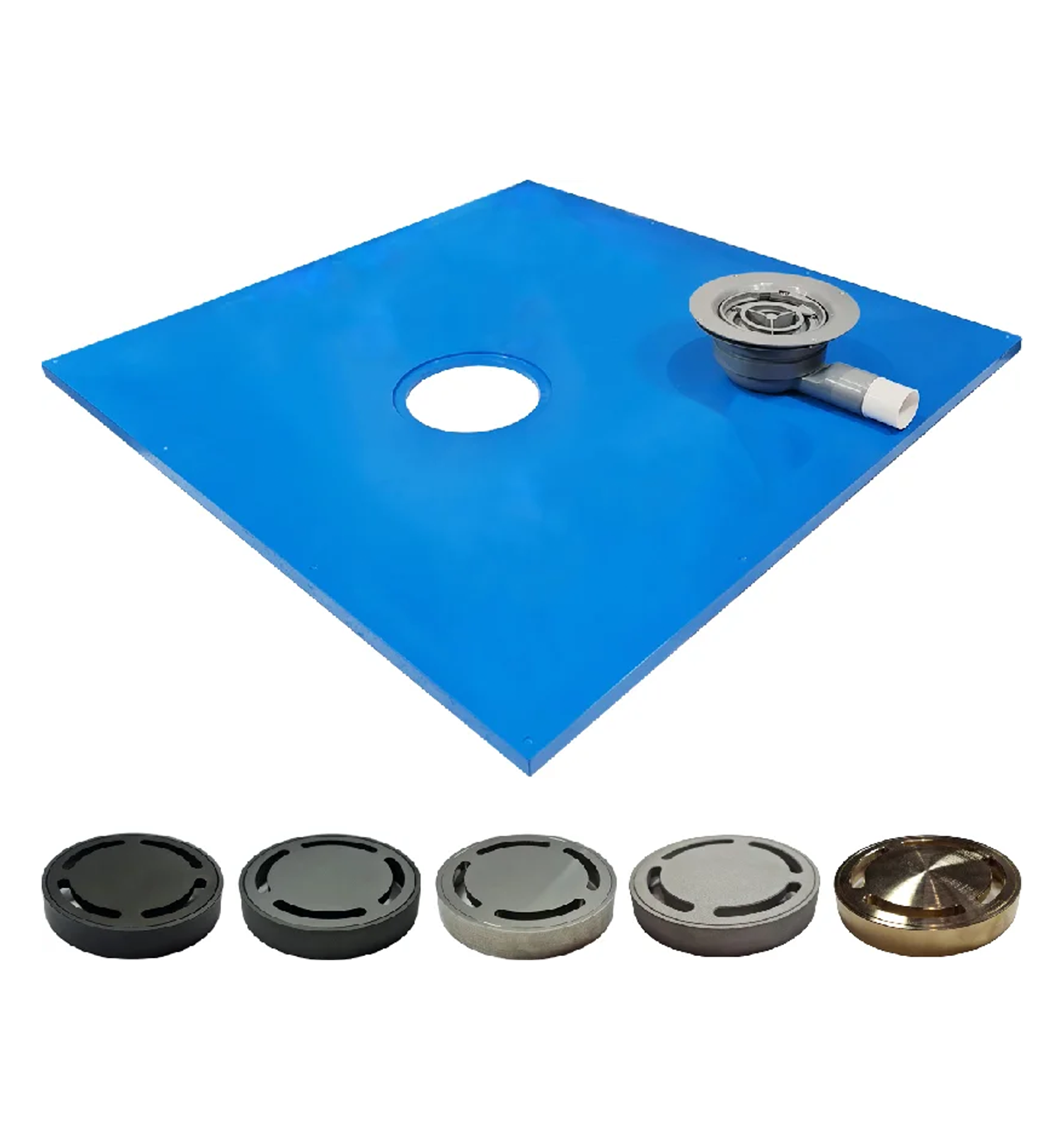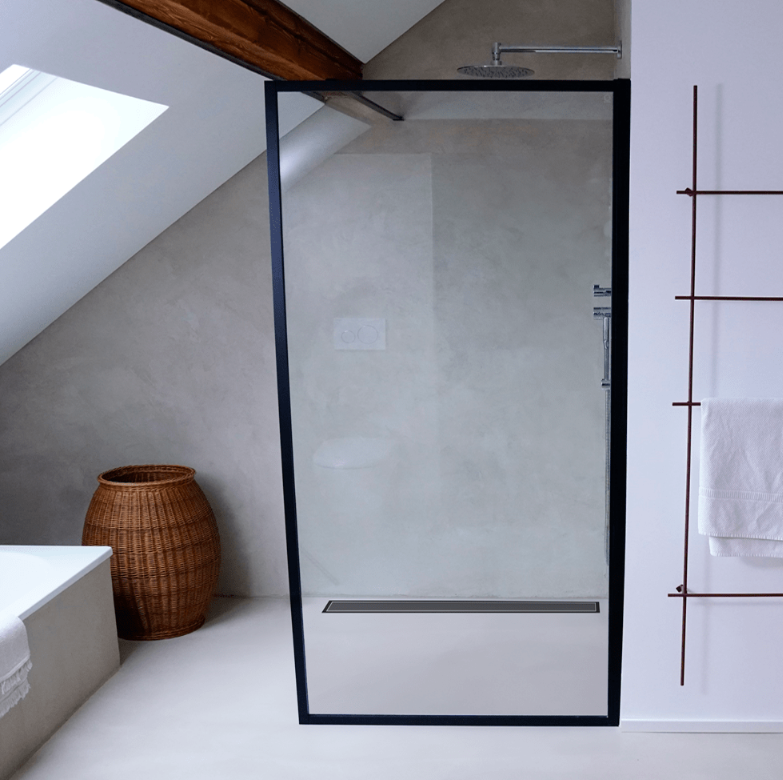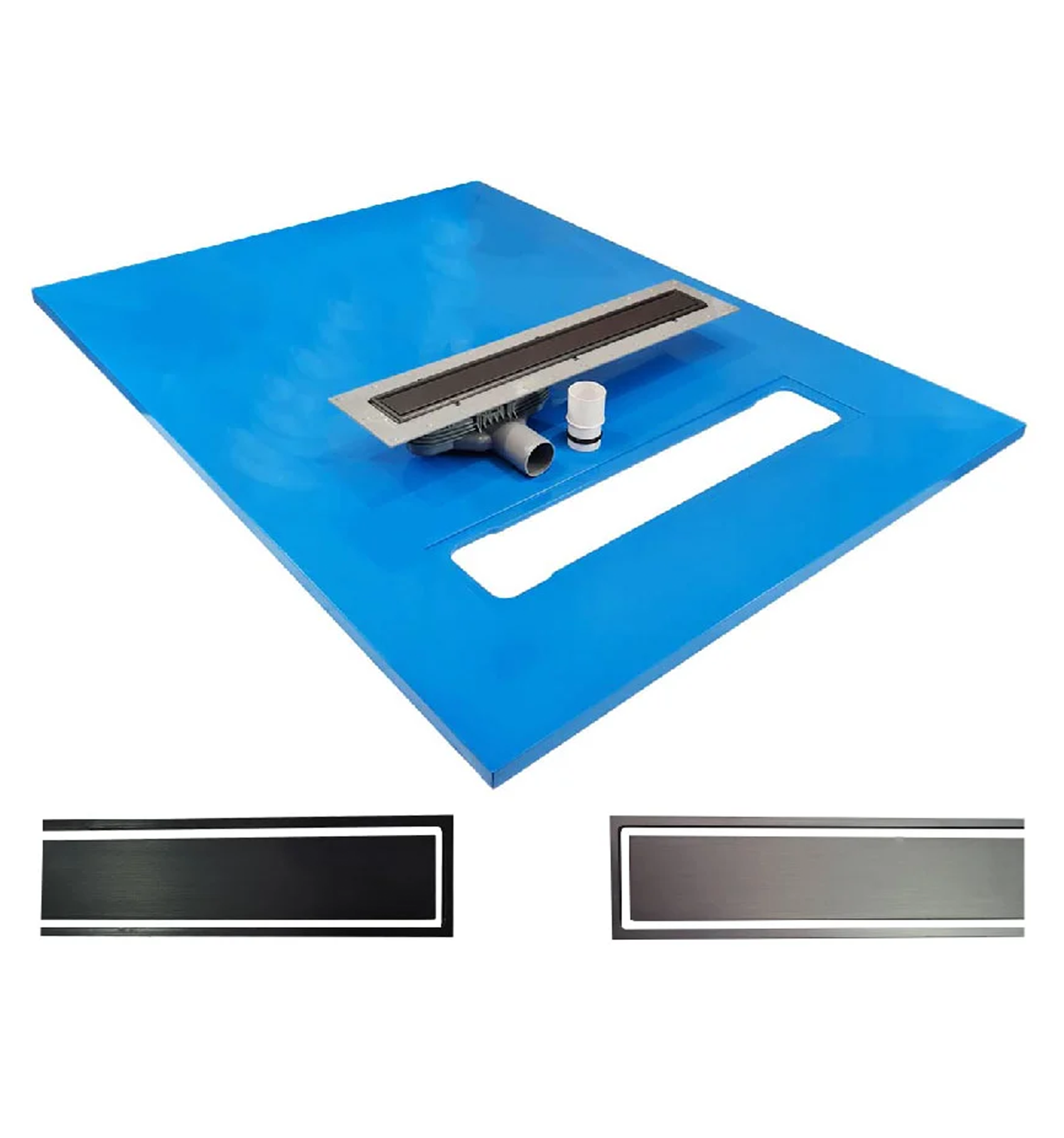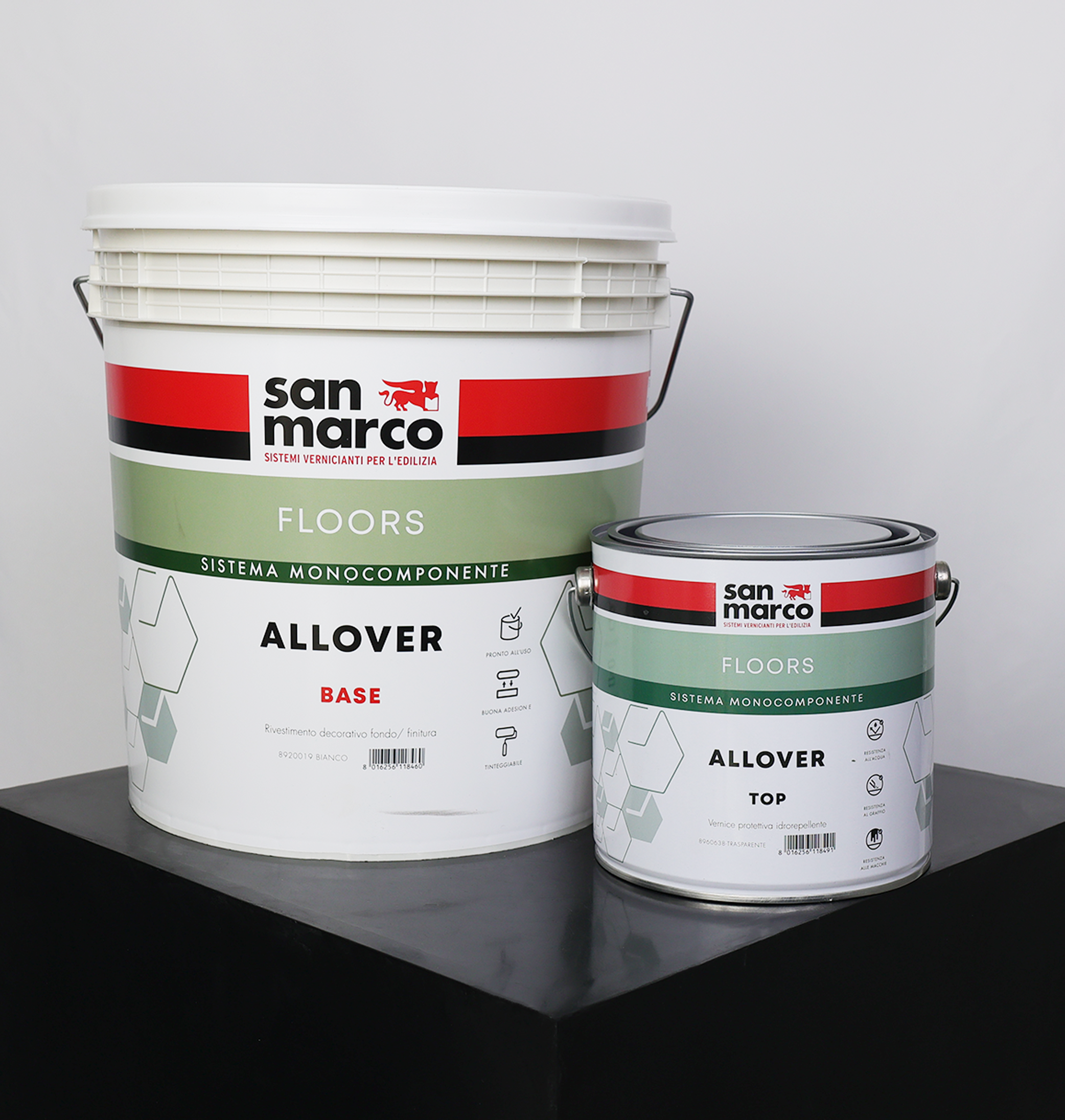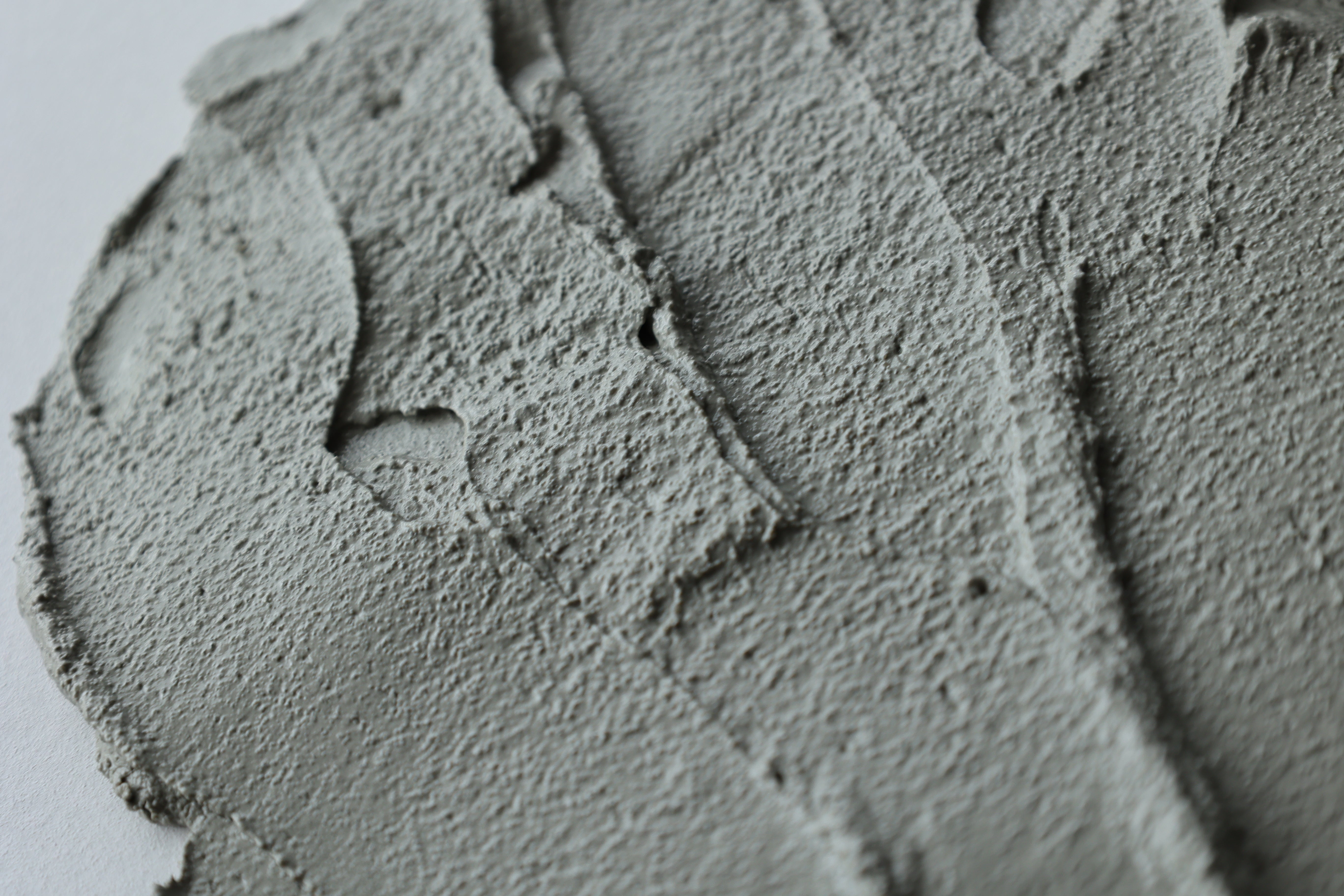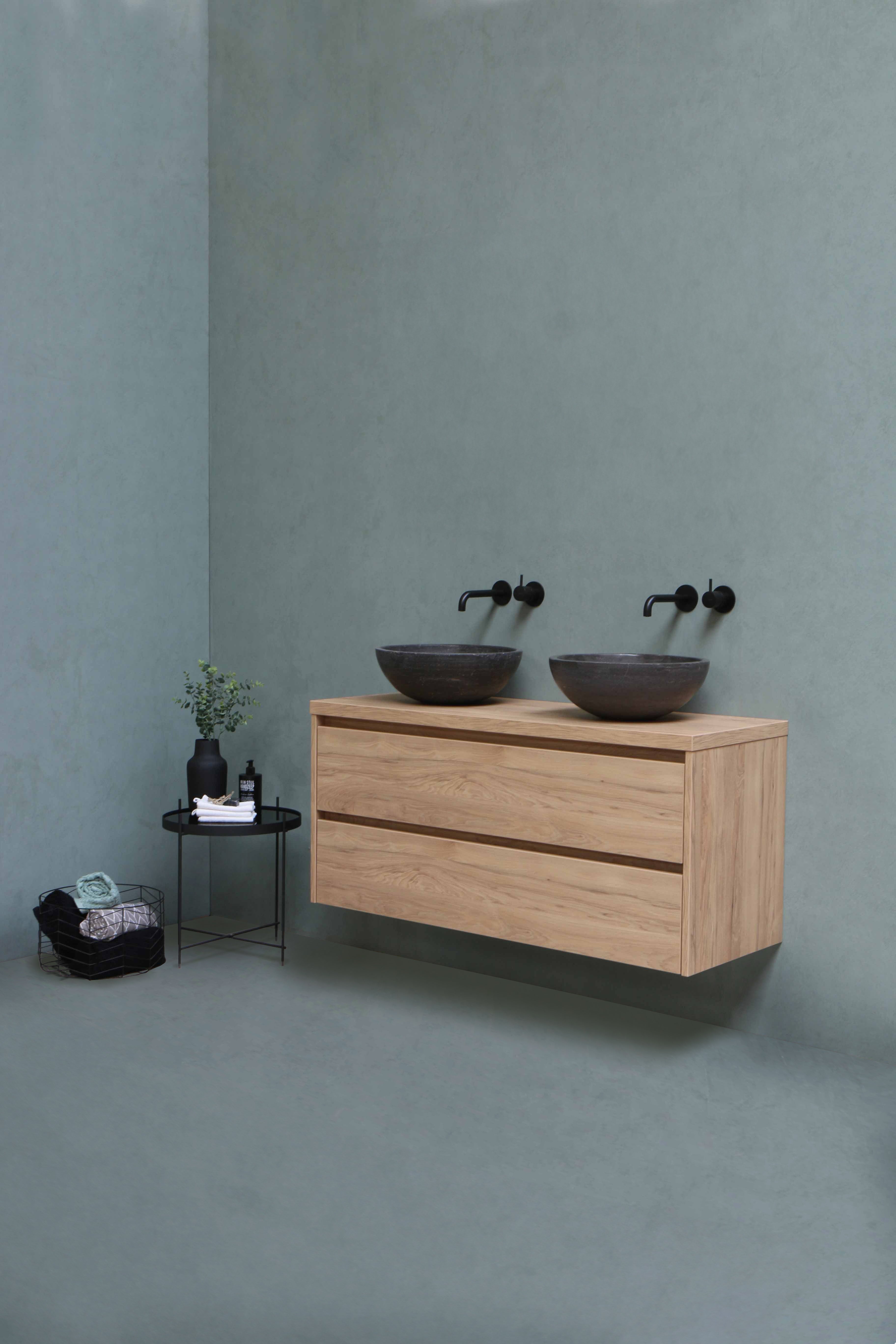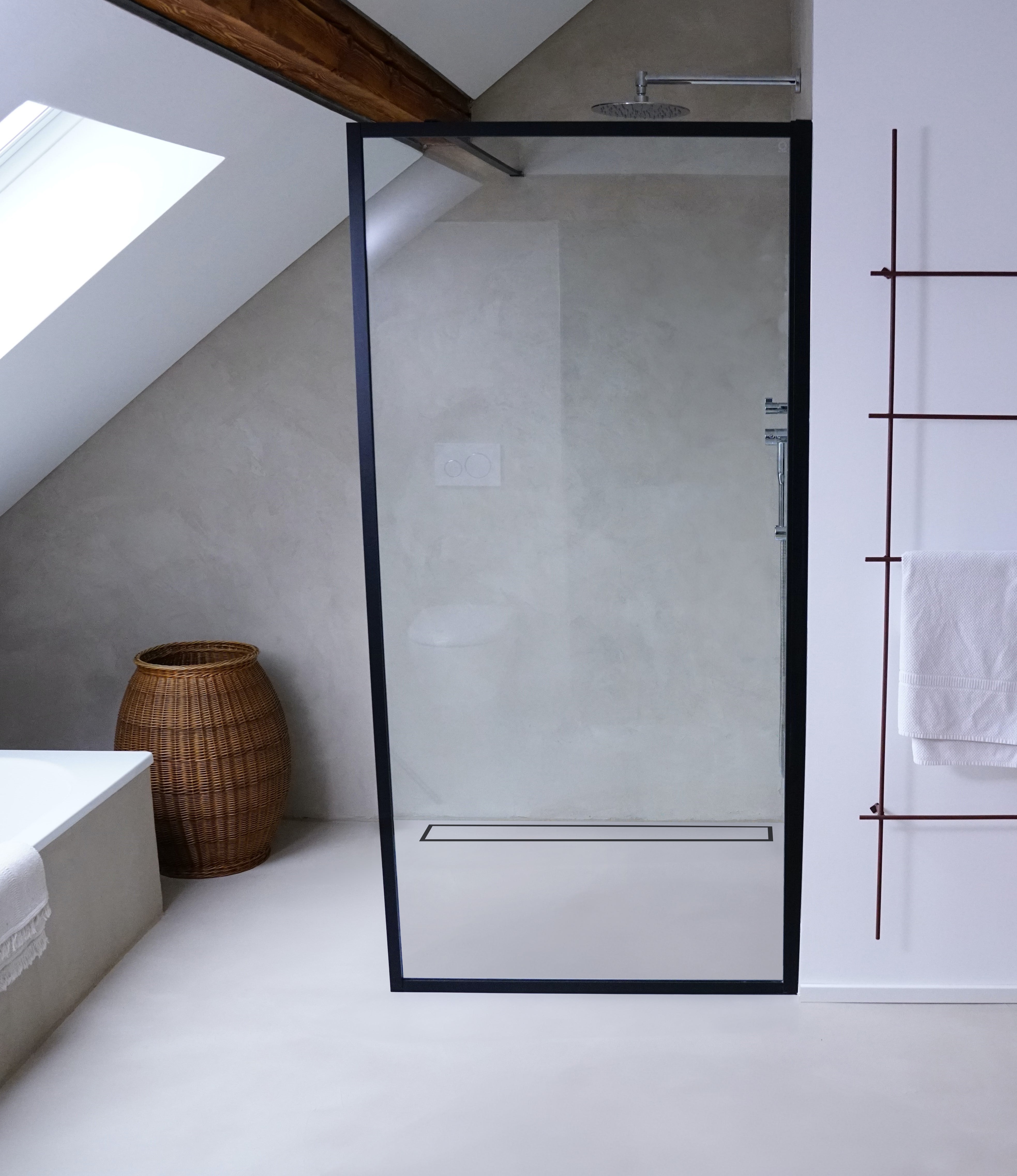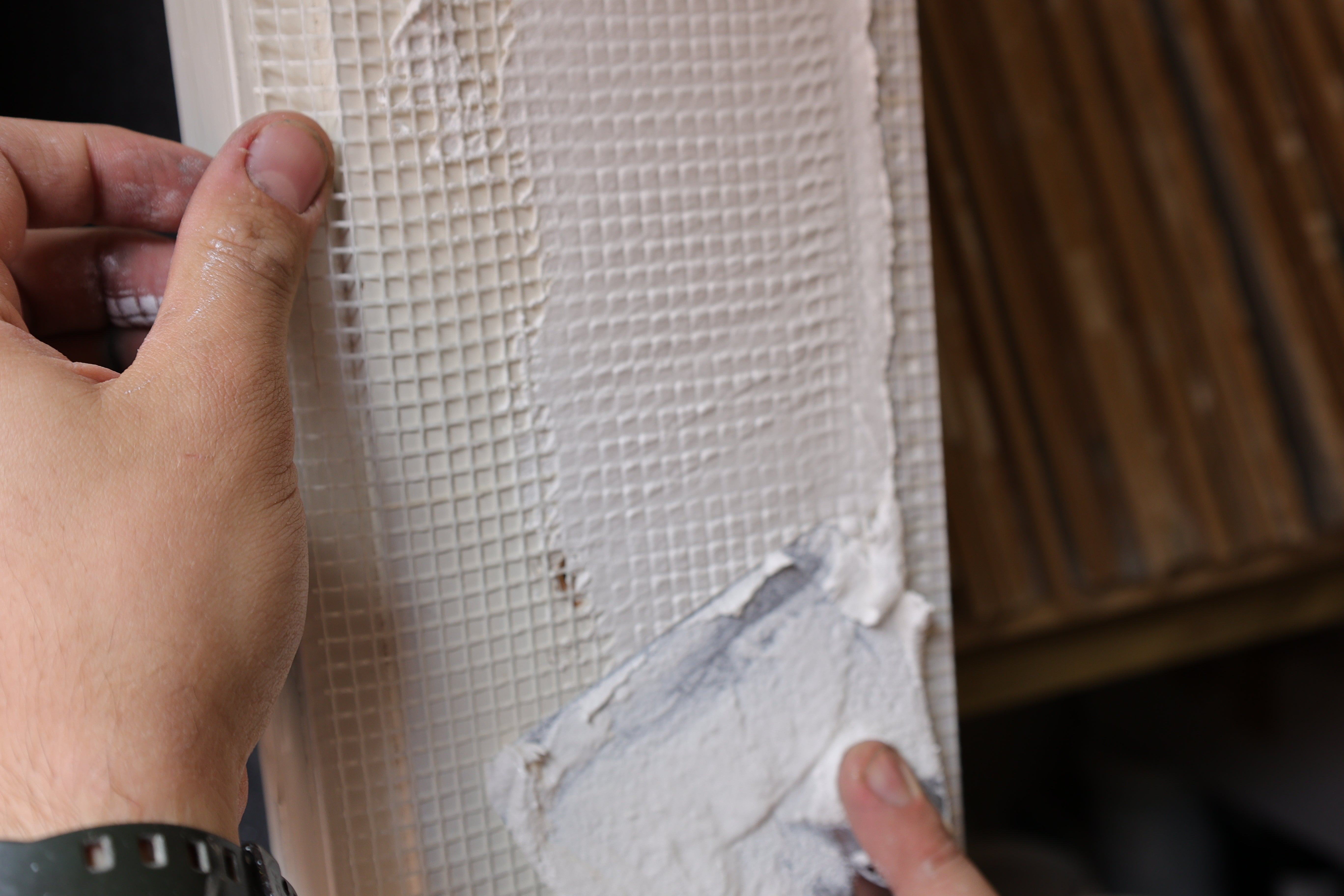Guide
What is Microcement?
Microcement, also known as micro concrete or microtopping, is a decorative, cement-based coating applied in thin layers to various surfaces, offering a sleek, modern finish. It's a versatile material that has gained popularity in contemporary interior and exterior design due to its durability, aesthetic appeal, and adaptability.
Composition and Application
Microcement is typically composed of a blend of cement, polymers, and colour pigments. This mixture creates a highly adhesive and flexible material that can be applied to surfaces such as floors, walls, countertops, and even furniture. The application process involves multiple thin layers, usually between 2 to 3 millimetres thick, which are trowelled onto the surface and then sealed to enhance its durability and water resistance.
The steps for applying microcement generally include:
Surface Preparation: The existing surface is cleaned, repaired, and primed to ensure proper adhesion.
Base Coat Application: A base layer is applied to create a smooth foundation.
Microcement Coats: Several layers of microcement are trowelled on, each allowed to dry before the next is applied.
Sanding: The surface is sanded between coats to achieve the desired smoothness and finish.
Sealing: A protective sealer is applied to enhance durability and provide a waterproof barrier.
Advantages of Microcement
Microcement offers numerous benefits that make it an attractive option for both residential and commercial spaces:
Seamless Finish: One of the most notable features is its ability to create a seamless, continuous surface without the need for joints or grout lines. This gives a clean, contemporary look that is easy to maintain.
Versatility: It can be applied to a variety of substrates, including concrete, tile, plaster, and drywall, making it suitable for renovations and new constructions alike.
Durability: Despite its thin application, microcement is remarkably durable and resistant to wear.
Waterproof: When properly sealed, microcement is water-resistant, making it ideal for bathrooms and kitchens.
Customizable: Available in a wide range of colours and finishes, microcement can be tailored to fit any design aesthetic, from industrial to minimalist.
Design Flexibility
Microcement is favoured by designers and architects for its aesthetic flexibility. It can mimic various textures, such as polished concrete, marble, or stone, allowing for creative expression in interior and exterior designs. Additionally, its ability to adhere to different surfaces means it can be used in innovative ways, from flooring to accent walls and custom furniture.
Maintenance and Longevity
Maintaining microcement surfaces is relatively straightforward. Regular cleaning with mild detergents and water is usually sufficient to keep it looking new. The durability and low maintenance requirements make it an economical choice over time. However, it is advisable to periodically reapply the protective sealer to maintain its waterproof properties and prolong its lifespan.
Eco-Friendly Option
Microcement is also considered an environmentally friendly option. Its application involves less material compared to traditional cement overlays, reducing waste. Moreover, its long lifespan and low maintenance reduce the need for frequent replacements and repairs, contributing to sustainability.
Conclusion
Microcement is a modern, versatile, and durable material that offers a sleek, seamless finish for various surfaces. Its adaptability, range of finishes, and ease of maintenance make it a popular choice for contemporary design projects. Whether for residential or commercial use, microcement provides a stylish and practical solution for creating beautiful, enduring spaces.
10 Advantages of Microcement
Microcement, a cement-based coating, has become increasingly popular in modern architecture and interior design due to its versatility, durability, and aesthetic appeal. Here are ten key advantages that make microcement a favoured material in both residential and commercial projects:
1. Seamless Finish
One of the most significant advantages of microcement is its ability to create a seamless, continuous surface. Unlike traditional tiling, which requires grout lines, microcement is applied in thin layers that bond together, resulting in a smooth, uninterrupted finish. This seamless look is not only visually appealing but also easier to clean and maintain, as there are no joints where dirt and grime can accumulate.
2. Versatility
Microcement can be applied to a wide range of substrates, including concrete, tile, plaster, drywall, and wood. This versatility makes it suitable for various applications, such as floors, walls, countertops, and even furniture. Its adaptability allows designers to use it in both new constructions and renovations, providing a consistent look across different surfaces.
3. Durability
Despite its thin application (typically 2-3 millimetres), microcement is highly durable and resistant to wear and tear. It can withstand heavy foot traffic, making it ideal for high-traffic areas in both residential and commercial settings. Additionally, it has a good level of resistance to impacts, scratches, and chemical damage, ensuring a long-lasting finish that maintains its appearance over time.
4. Waterproof
When properly sealed, microcement is highly resistant to water and moisture, making it an excellent choice for bathrooms, kitchens, and outdoor areas. Its waterproof nature prevents the growth of mould and mildew, which is a common issue with other materials in wet environments. This makes microcement a hygienic and practical option for spaces exposed to water.
5. Aesthetic Flexibility
Microcement offers a wide range of aesthetic options, allowing for customization in terms of colour, texture, and finish. It can be tinted with various pigments to match any design scheme, and different application techniques can create unique textures, from smooth and polished to rough and rustic. This flexibility makes it suitable for various design styles, from minimalist and modern to industrial and traditional.
6. Quick Installation
Compared to other flooring and wall finishing options, microcement is relatively quick to install. It can be applied directly over existing surfaces without the need for extensive demolition or preparation. This reduces the overall project timeline and minimises disruption to the space, making it an efficient choice for renovations and new builds alike.
7. Low Maintenance
Microcement requires minimal maintenance to keep it looking new. Regular cleaning with mild detergents and water is usually sufficient to maintain its appearance. Unlike other materials that may require periodic resealing or refinishing, Microcement's durable finish and resistance to stains and spills make it a low-maintenance option.
8. Eco-Friendly
Microcement is considered an environmentally friendly material for several reasons. Its application involves using a minimal amount of material compared to traditional cement overlays, reducing waste. Additionally, its long lifespan and low maintenance needs mean fewer resources are required for replacements and repairs. Furthermore, many microcement products are made with eco-friendly components, contributing to sustainable building practices.
9. Heat Resistance
Microcement is resistant to high temperatures, making it suitable for areas exposed to heat, such as kitchens and fireplaces. Its heat-resistant properties prevent it from cracking or discolouring when exposed to temperature fluctuations, ensuring a durable and aesthetically pleasing finish in heat-prone areas.
10. Increased Property Value
Using microcement in your home or commercial space can enhance its overall value. Its modern, sleek appearance and durability appeal to potential buyers and tenants, making the property more attractive in the real estate market. The investment in a high-quality, long-lasting material like microcement can provide a significant return on investment by improving both the functionality and aesthetics of the space.
Conclusion
Microcement offers a multitude of advantages that make it an excellent choice for a variety of applications. Its seamless finish, versatility, durability, and low maintenance requirements make it a practical and attractive option for modern design. Whether used in residential or commercial projects, microcement provides a stylish, durable, and eco-friendly solution that enhances the value and appeal of any space. Its aesthetic flexibility and quick installation further contribute to its growing popularity, making it a top choice for designers and architects looking to create beautiful, functional environments.
Applications of Microcement
Microcement, known for its versatility and aesthetic appeal, can be applied to a variety of surfaces in both residential and commercial settings. Its adaptability allows for creative uses across different environments, providing a seamless, modern finish that enhances the overall design. Here are some key areas where microcement can be effectively applied:
1. Floors
Microcement is a popular choice for flooring due to its durability and seamless appearance. It can be applied over existing substrates like concrete, tile, or wood, making it an ideal solution for renovations without the need for extensive demolition. Its resistance to foot traffic and easy maintenance make it suitable for:
Residential homes: Living rooms, bedrooms, kitchens and hallways.
2. Walls
Applying microcement to walls can transform any space with a sleek, contemporary look. It is particularly favoured in open-plan designs where a continuous surface without joints can enhance the sense of space. Microcement walls are ideal for:
Interior walls: Living rooms, bedrooms, bathrooms, kitchens and entryways.
Feature walls: Accent walls in living areas or behind fireplaces.
Commercial interiors: Office reception areas, lobbies, and retail spaces.
3. Bathrooms
The waterproof nature of microcement makes it an excellent choice for bathrooms. It can be used to create a cohesive, spa-like environment by covering various surfaces, including:
Floors and walls: Providing a unified look that is easy to clean.
Shower enclosures: Creating a sleek, joint-free surface that is resistant to mould and mildew.
Vanity tops: Offering a durable and stylish alternative to traditional materials.
4. Kitchens
In kitchens, Microcement's resistance to stains and high temperatures makes it a practical and attractive option. It can be used for:
Countertops and worktops: Providing a seamless, easy-to-clean surface.
Backsplashes: Adding a contemporary touch that is resistant to splashes and spills.
Floors: Creating a durable, easy-to-maintain flooring option that complements modern kitchen designs.
5. Furniture and Custom Designs
Microcement can also be applied to furniture and custom design elements, adding a unique touch to interior decor. Some examples include:
Tables and countertops: Enhancing the durability and aesthetic appeal of dining tables, coffee tables, and kitchen islands.
Shelves and cabinetry: Providing a sleek, modern finish that integrates seamlessly with the overall design.
Staircases: Creating a stylish, continuous look for treads and risers.
Advantages of Using Microcement
The widespread application of microcement is due to its numerous benefits:
Seamless finish: Creates a smooth, joint-free surface that is easy to clean and maintain.
Durability: Resistant to wear, impact, and chemical damage, making it suitable for high-traffic areas.
Versatility: Can be applied to various surfaces and tailored to different textures and colours.
Waterproof: Ideal for wet areas like bathrooms and kitchens when properly sealed.
Quick installation: Can be applied over existing surfaces, reducing the need for extensive demolition and speeding up renovation projects.
Conclusion
Microcement's versatility and range of applications make it an ideal material for modern design. From floors and walls to kitchens, bathrooms, and outdoor areas, microcement provides a durable, stylish, and practical solution for a variety of surfaces. Its seamless finish and adaptability ensure that it meets both aesthetic and functional requirements, making it a popular choice for contemporary interior and exterior designs.
Advantages of Microcement over tiles
Microcement and tiles are two popular choices for flooring and wall coverings in both residential and commercial environments. While tiles have been a traditional favourite due to their durability and variety, microcement has emerged as a formidable contender, offering a seamless and contemporary look that appeals to modern aesthetic sensibilities. This article explores the advantages of microcement over tiles, detailing why it may be the superior choice for various applications.
Comparison of Features
Durability and Maintenance: Microcement boasts a high level of durability and a seamless finish that eliminates grout lines, which are often the weakest point in tiled surfaces. This makes microcement less susceptible to the growth of mould and bacteria and easier to clean and maintain.
Installation Process: Unlike tiles, which require careful alignment and grouting, microcement can be applied directly over existing surfaces without the need for demolition. This streamlined process not only reduces installation time but also minimizes the mess and inconvenience associated with traditional tiling.
Environmental Impact: Microcement is an eco-friendlier option compared to ceramic tiles. Its application involves fewer raw materials and produces less waste. Additionally, the ability to overlay microcement on existing surfaces reduces the need for removal and disposal of old materials.
Benefits in Applications
Residential: In homes, microcement offers a continuous surface that can flow seamlessly from one room to another, creating a sense of space and unity. Its ability to resist moisture makes it ideal for kitchens, bathrooms, and basements.
Commercial: For commercial spaces, the quick installation and minimal maintenance of microcement ensure lower downtime for businesses. Its robustness makes it suitable for high-traffic areas such as restaurants, hotels, and retail stores.
Aesthetic Versatility
Microcement offers a vast array of textures and colours, allowing for customization that tiles might not always accommodate. It can be polished to a high gloss, honed to a matte finish, or textured for slip resistance, providing designers and homeowners with creative freedom.
Cost Considerations
Initial installation costs for microcement might be higher than those for tiles, but the overall investment often proves cost-effective. The longevity and reduced maintenance needs of microcement contribute to lower lifecycle costs. Furthermore, the ease of application over existing surfaces can lead to significant savings in labour and materials.
Conclusion
Microcement presents a strong case over tiles with its seamless aesthetics, superior durability, and versatility. As architectural and design preferences continue to evolve towards more minimalist and sustainable practices, microcement is likely to become an increasingly popular choice. Its advantages make it not only a stylistically versatile option but also a practical one for a variety of settings and purposes.
This overview has been designed to offer a detailed comparison and clear insights into why microcement can be a superior choice for your next project. If there are any other specific points or areas you would like to delve deeper into, let me know, and I can adjust or expand any section as needed.
Differences between Microcement & Polished concrete
Microcement and polished concrete are popular flooring options that offer durable, attractive finishes. Despite their similarities, these materials have distinct characteristics, installation processes, and applications. Here’s a detailed comparison to help you understand their differences:
1. Composition and Structure
Microcement:
Composition: Microcement is a blend of cement, polymers, aggregates, and pigments. It is applied as a thin coating, usually 2-3 millimetres thick, over various substrates.
Structure: It is a layered material that can be applied over existing surfaces like concrete, tile, or wood.
Polished Concrete:
Composition: Polished concrete is made from traditional concrete, which consists of cement, aggregates (such as gravel or crushed stone), and water.
Structure: It is a solid, monolithic material that involves polishing the surface of a concrete slab to achieve a smooth, shiny finish.
2. Application Process
Microcement:
Surface Preparation: The existing surface is cleaned, repaired, and primed.
Layering: Microcement is applied in several thin layers with a trowel, with each layer sanded and allowed to dry before the next is added.
Sealing: A protective sealer is applied to enhance durability and water resistance.
Polished Concrete:
Initial Pouring: A new concrete slab is poured, or an existing slab is used.
Grinding: The surface is ground down using progressively finer diamond abrasives.
Polishing: The concrete is polished to the desired level of sheen, often involving multiple passes.
Sealing: A densifier and sealant are applied to protect the surface and enhance shine.
3. Thickness and Weight
Microcement:
Thickness: Typically, 2-3 millimetres, adding minimal height to the existing surface.
Weight: Very light compared to traditional concrete, making it suitable for areas where added weight is a concern.
Polished Concrete:
Thickness: The thickness depends on the depth of the concrete slab, usually several inches.
Weight: Heavy, due to the substantial volume of concrete used.
4. Flexibility and Versatility
Microcement:
Flexibility: Highly flexible and can be applied over a variety of surfaces, including floors, walls, countertops, and furniture.
Versatility: Available in a wide range of colours and finishes, suitable for both interior and exterior applications.
Polished Concrete:
Flexibility: Limited to horizontal surfaces like floors and countertops.
Versatility: Primarily available in a natural concrete colour, though dyes and stains can be used to add colour. Best suited for large, open spaces.
Impera's 2 types of Coating
| Continuo Microcement | All Over Micro Coating | |
|---|---|---|
| Components | 2-Part (Mixing Required) | Single component (Ready to apply) |
| Layers | 8 | 5 |
| Primer required | Yes | No |
| Key Differences | The continuo system requires a set of scales. This is due to most components needing to be measured, in order to mix accurate quantities. The additional step of applying the LINK coat, adds time to the overall application. | All Over was designed with the intention of being easier, and faster to apply, with the goal of being single component. This avoids the use of powders, as well as weighing scales. This results in the additional benefits of a reduced application time, as well as less wastage, as any left overs can simply be covered up and kept for future projects. |
| Application Difficulty | 5. Specialist coating for professionals | 5. Specialist coating for professionals |
| Water Resistant | Yes | Yes |
| Shower Tray Compatible | Yes | Yes |
| Available Colours | 30 | 20 |
| Mood board Set Available | Yes | No |
| Colour Matches Available? | Yes | Yes |
| Visual Appeal | Easy to discolour during application, great for visibly textured finishes. | Ideal for more seamless, undisturbed finishes due to higher resistance to burnishing. |
| Sizes | 5sqm, 10sqm | 10sqm |
| Sample Kit available? | Yes | Yes |
| Price of Full Kit (10sqm With Anticrack) | £450 VAT INC | £540 VAT INC |
The Continuo Application
Surface Preparation
Ensure the substrate is solid. The surface is smooth and has been prepared without any cracks. There should be no dust or any particles, so that the primer can adhere adequately.
Primer Application (1+ coats)
The correct primer can now be applied to the surface. Atomo is the most common primer, which is usually used for porous surfaces. In the event of applying on a non porous surface, Prolink would be the correct primer.
The Anticrack System (2 Coats)
The Anticrack system should be applied, depending on the substrate. This is essentially a basecoat with embedded mesh, that is used to prevent the Microcement from cracks due to movement of the substrate.
Decorative Coat (2 Coats)
This can be applied both on top of the basecoat if the Anticrack was used, or directly onto the primer if the anticrack was not used. These 2 coats of plaster will create the finish that will eventually be your surface. A good eye for details and technique is required in order to achieve something even, consistent and beautiful.
The Link (1 Coat)
Link is a pre-sealer, this means it works almost like a primer for the resin protector. Link is designed to penetrate the decorative coat, and seal its pores. Link will change the colour from that of the plaster, by making it a little deeper. This is why, a Microcement sample can only be presented accurately, when the Link coat has been applied.
The Top (2 Coats)
Continuo Top is the main resin sealer used to protect a Microcement surface. Available in Matt, Satin or Gloss, this sealer will form a layer on top of the Microcement, that is non porous, and resistant to water.
Continuo Microcement
Continuo has stood the test of time. Its natural, comforting colours and array of application methods, make it the first choice for new, as well as seasoned applicators.
The Continuo range has been sold at Impera Italia for over 5 years. This is a relatively long time for a Microcement system in the UK. In this time, it has proven its reliability and workability. It is admired by applicators for the freedom it affords sits applicators to design truly incredible spaces.

The All Over Application
Surface Preparation
Ensure the substrate is solid. The surface is smooth and has been prepared without any cracks. There should be no dust or any particles, so that the primer can adhere adequately.
Primer Application?
The All Over Micro coating does not necessarily need a primer before it is applied to porous substrates. The plasters that form the basis of this material are better at adhering to surfaces. In the even of applying on a non-porous surface, Prolink Primer should be used.
The Anticrack System (2 Coats)
Much like the Continuo, All over has its own Anticrack system that should be applied on to floors each and every time. On walls however, it is possible to apply only the basecoat for a textured finish, or only the finishing coat for a smooth finish. This means that All Over can technically be applied in 4 layers!
Decorative Coat (2 Coats)
This can be applied both on top of the basecoat if the Anticrack was used, or directly onto a primed, or un-primed substrate if the anticrack was not used. These 2 coats of plaster will create the finish that will eventually be your surface. A good eye for details and technique is required in order to achieve something even, consistent and beautiful.
The Link
All Over does NOT require a link coat, meaning this step is skipped entirely.
The Top (2 Coats)
Although All Over has its own mono-component sealer, Our tests show that the Continuo Protector is still the preferred solution. This also gives the choice of Matt, satin & Gloss. The All Over protector is only available in Semi-Matt
All Over
The All Over system, is a brand new, Micro coating system designed to be faster and easier to apply, whilst providing the same excellent advantages of the Continuo range.
All Over makes it easier and faster to carry out a project. This fantastic material, one of the most advanced in the industry, is strong, durable, and less prone to mistakes and wastage. All Over is also better suited to very seamless, uniform finishes that blend large spaces into endless canvasses of colour and texture. An absolutely winner in the world of minimalistic interior design.
Applying Microcement In Bathrooms
Microcement is an excellent choice for bathroom surfaces due to its seamless finish, water resistance, and versatility. Here’s an overview of the benefits and application process for using microcement in bathrooms:
Aesthetic and Design Flexibility
Microcement provides a sleek, modern look that enhances the aesthetic of bathroom spaces. It can be customized with a variety of colours and finishes, allowing for unique design elements that can complement any style, from minimalist to luxurious.
Seamless Finish: Microcement’s smooth, joint-free surface is ideal for creating a clean and continuous look, reducing areas where mould and mildew can form.
Variety of Textures and Colours: Available in numerous shades and textures, microcement can be tailored to fit specific design visions.
Durability and Water Resistance
Microcement is highly durable and water-resistant, making it perfect for bathroom environments where moisture and humidity are constant concerns.
Waterproof: When sealed properly, microcement forms a waterproof barrier, protecting underlying surfaces from water damage.
High Durability: Resistant to stains, scratches, and wear, microcement is suitable for floors, walls, shower enclosures, and countertops in bathrooms.
Application Process
The application of microcement in bathrooms involves several key steps to ensure a high-quality, durable finish:
Surface Preparation: The existing surface must be thoroughly cleaned, free of grease and debris, and any cracks or imperfections should be repaired.
Priming: Apply a primer to enhance the adhesion of the microcement to the substrate.
Base Coats Application: Apply a base coat or coats of microcement with or without mesh to create a strong foundation. This layer is typically 2 millimetres thick.
Decorative Coats: The decorative layers provides the aesthetic finish, with options ranging from smooth and polished to textured.
Sealing: Apply a high-quality sealant and sealer to protect the surface from water, stains, and daily wear. Multiple coats of sealer may be needed for optimal protection.
Maintenance
Maintaining microcement in bathrooms is straightforward. Regular cleaning with mild detergents and water is typically sufficient to keep the surfaces looking new. Periodic resealing is recommended to maintain the waterproof properties and prolong the lifespan of the microcement.
Easy to Clean: The smooth, seamless surface is easy to wipe down and maintain.
Low Maintenance: Requires occasional resealing to keep the protective layer intact.
Conclusion
Microcement is a versatile, durable, and stylish option for bathroom surfaces. Its seamless, waterproof finish makes it ideal for high-moisture environments, while its aesthetic flexibility allows for a wide range of design possibilities. The straightforward application process and low maintenance requirements further enhance its appeal for both residential and commercial bathrooms.
Applying Microcement on Floors
Microcement is a popular choice for flooring due to its seamless finish, durability, and versatility. Here's a detailed overview of using microcement for floors:
Aesthetic and Design Flexibility
Microcement provides a sleek, modern appearance that enhances the aesthetic of any space. It is available in a variety of colours and textures, allowing for extensive customization to match different interior styles, from industrial to minimalist.
Seamless Finish: The absence of grout lines gives a continuous, clean look.
Customizable Textures and Colours: Options range from smooth and polished to more textured and rustic finishes, accommodating various design preferences.
Durability and Maintenance
Microcement is known for its durability and resistance to wear, making it an ideal flooring option for high-traffic areas. When properly sealed, it is resistant to water, stains, and scratches, ensuring long-term performance.
High Durability: Suitable for both residential and commercial use, standing up to heavy foot traffic and impact.
Easy Maintenance: Simple cleaning with mild detergents and water is typically sufficient to keep the floor looking new. Regular resealing helps maintain its protective properties.
Application Process
The application of microcement on floors involves several meticulous steps to ensure a durable and visually appealing finish:
Surface Preparation: The existing floor must be clean, dry, and free of debris. Any cracks or uneven areas should be repaired.
Priming: A primer is applied to promote adhesion between the substrate and microcement.
Base Coats: A base layers of microcement with or without mesh is applied to create a stable foundation.
Finishing Coats: The final layer provides the desired texture and colour.
Sealing: A protective sealant and sealer is applied to enhance durability and water resistance.
Environmental Benefits
Microcement is considered an eco-friendly flooring option. Its application involves using minimal material, which reduces waste. Additionally, many microcement products are low in volatile organic compounds (VOCs), contributing to better indoor air quality.
Minimal Material Use: Thin application layers mean less raw material consumption.
Low VOC Emissions: Enhances indoor air quality and reduces environmental impact.
Conclusion
Microcement is a versatile, durable, and aesthetically pleasing flooring option that offers a seamless and customizable finish. Its resilience to wear and ease of maintenance make it suitable for both residential and commercial spaces. The eco-friendly aspects further enhance its appeal, making it a preferred choice for modern flooring solutions.
Can Microcement Be Used With Underfloor Heating
Yes, microcement can be used with underfloor heating systems. Its compatibility with underfloor heating is one of the many reasons it is a popular choice for flooring in modern homes and commercial spaces. Here are the key points to consider when using microcement with underfloor heating:
Benefits of Using Microcement with Underfloor Heating
Thermal Conductivity:
Microcement has good thermal conductivity, which means it efficiently transfers heat from the underfloor heating system to the surface. This ensures an even and comfortable temperature distribution across the floor.
Flexibility:
The polymers in microcement provide flexibility, which helps the material withstand the expansion and contraction caused by temperature changes. This flexibility reduces the risk of cracking due to thermal stress.
Seamless Finish:
Microcement creates a seamless surface without joints or grout lines, which helps in evenly distributing heat and maintaining consistent temperatures across the floor.
Thin Application:
The thin application layer of microcement (typically 2-3 mm) allows for efficient heat transfer and quick warming of the surface. It also minimizes the additional height added to the floor, which can be beneficial in renovations where floor height is a concern.
Installation Considerations
Proper Substrate Preparation:
Check the minimum thickness of screed or any substrate over underfloor heating with manufacturer before calculating heights of new floor.
Ensure the substrate is stable and free of any existing cracks. Any movement in the substrate can lead to issues in the microcement layer, especially when combined with the heating and cooling cycles of underfloor heating.
Insulation:
Proper insulation beneath the underfloor heating system is crucial. It ensures that the heat is directed upwards into the room rather than being lost downwards.
Gradual Heating:
When using underfloor heating with microcement for the first time, it's important to gradually increase the temperature. This allows the materials to acclimate and reduces the risk of thermal shock, which can cause cracking.
Professional Installation:
Given the technical requirements of both underfloor heating and microcement application, it's advisable to hire professionals with experience in installing both systems. This ensures that the installation is done correctly and reduces the risk of future issues.
Curing Time:
Allow adequate curing time for the microcement before turning on the underfloor heating system. Typically, this involves waiting for at least two weeks after the final application of the microcement to ensure it has fully cured and hardened.
Maintenance Tips
Temperature Control:
Avoid setting the underfloor heating to very high temperatures. Keeping a moderate and consistent temperature helps in maintaining the integrity of the microcement.
Regular Cleaning:
Clean the microcement surface regularly with mild soap and water to maintain its appearance and longevity. Avoid using harsh chemicals that can damage the sealant.
Conclusion
Microcement is an excellent choice for use with underfloor heating systems due to its good thermal conductivity, flexibility, and seamless finish. Proper installation and maintenance are key to ensuring that the microcement performs well and remains durable when combined with underfloor heating. By following the recommended practices, you can enjoy the benefits of both a stylish microcement floor and the comfort of underfloor heating.
Applying Microcement On Stairs
Microcement is an excellent choice for covering stairs due to its durability, seamless finish, and versatile aesthetic options. Here’s a detailed overview of how to apply microcement on stairs:
Benefits of Microcement on Stairs
Seamless Finish: Microcement provides a smooth, joint-free surface, eliminating grout lines where dirt can accumulate.
Durability: It is highly resistant to wear, making it suitable for high-traffic areas like stairs.
Slip Resistance: When applied with a textured finish, microcement can provide a non-slip surface, enhancing safety.
Aesthetic Flexibility: Available in various colours and finishes, microcement can match any design style, from modern to rustic.
Application Process
Surface Preparation:
Cleaning: Thoroughly clean the existing stair surface to remove dust, grease, and debris.
Repairing: Fill any cracks or imperfections with a suitable filler and sand smooth.
Priming: Apply a primer to enhance adhesion. The type of primer depends on the substrate material (e.g., concrete, wood).
Base Coat Application:
Sets corner beads, if necessary, Apply the base coat with a mesh using a trowel, even layer (approximately 1-2 millimetres thick). Allow it to dry completely. Then apply second coat of base plaster.
Sanding: Lightly sand the base coat to remove imperfections and ensure a smooth surface.
Decorative Coat Application:
Mixing: Prepare the decorative coat, adding pigments if a specific colour is desired.
Application: Apply the finishing coat with a trowel to achieve the final texture and appearance. This layer determines the aesthetic and functional qualities, such as slip resistance.
Sanding: Lightly sand the base coat to remove imperfections and ensure a smooth surface.
Sealing:
Sealer Application: Apply a sealant and sealer to protect the microcement surface from stains, water, and wear. Multiple coats may be necessary.
Drying: Allow each coat of sealer to dry thoroughly. The sealer enhances the durability and ease of maintenance of the microcement surface.
Maintenance
Regular Cleaning: Clean the stairs regularly with mild detergents and water. Avoid harsh chemicals that can damage the sealer.
Resealing: Periodically reseal the stairs to maintain their protective layer and ensure longevity. The frequency of resealing depends on the level of use.
Conclusion
Applying microcement to stairs offers a durable, aesthetically pleasing, and low-maintenance solution suitable for both residential and commercial properties. Its seamless finish and customizable appearance make it an ideal choice for modern design projects. With proper application and maintenance, microcement stairs can provide long-lasting beauty and functionality.
By following these steps and using high-quality materials, you can achieve a professional and attractive microcement finish on stairs that enhances both the safety and visual appeal of your space.
Applying Microcement On Walls
Microcement is an increasingly popular choice for wall finishes in both residential and commercial settings due to its seamless appearance, durability, and versatility. Here’s a comprehensive overview of using microcement on walls:
Aesthetic Appeal and Versatility
Microcement offers a sleek, modern finish that can transform the look of any space. It is available in a wide range of colours and textures, from smooth and polished to more textured, industrial looks. This flexibility allows for customization to suit various design styles, whether contemporary, minimalist, or rustic.
Smooth Finish: Ideal for modern, clean interiors, providing a seamless look without grout lines.
Textured Finish: Adds depth and character, suitable for feature walls and accent areas.
Durability and Maintenance
Microcement is known for its high durability and resistance to wear, making it an excellent choice for walls that require a robust finish. It is particularly useful in high-traffic areas or spaces exposed to moisture, such as bathrooms and kitchens.
Waterproof: When sealed properly, microcement is resistant to water, making it ideal for wet areas.
Easy Maintenance: The seamless surface is easy to clean and maintain, requiring only regular cleaning with mild detergents and water.
Application Process
The application of microcement on walls involves several steps to ensure a high-quality finish:
Surface Preparation: The wall surface must be clean, dry, and smooth. Any cracks or imperfections should be repaired.
Priming: A primer is applied to enhance adhesion.
Base Coat: A base layer/s of microcement with or without mesh is applied to create a solid foundation.
Decorative Coats: The final layer is applied to achieve the desired texture and appearance.
Sealing: A sealant and sealer is applied to protect the surface from stains and moisture.
Environmental Benefits
Microcement is an eco-friendly option, as it uses minimal material and can be applied over existing surfaces, reducing the need for demolition and new materials. Many microcement products are also low in volatile organic compounds (VOCs), improving indoor air quality.
Conclusion
Microcement is a versatile, durable, and aesthetically pleasing option for wall finishes. Its ability to provide a seamless, customizable surface makes it a popular choice for various design styles. The ease of maintenance and environmental benefits further enhance its appeal for both residential and commercial applications.
Does Microcement Crack
Microcement, also known as micro concrete or microtopping, is a versatile and increasingly popular material used for flooring, walls, and other surfaces. It is renowned for its seamless finish and ability to adhere to various substrates. However, like any construction material, microcement has its pros and cons, including the potential for cracking. Here's a detailed look at whether microcement cracks and what can influence this outcome:
Factors That Influence Cracking in Microcement
Substrate Condition:
Stability: The stability of the underlying substrate is crucial. If the substrate is prone to movement or has existing cracks, these issues can translate to the microcement layer.
Preparation: Proper preparation of the substrate, including cleaning, levelling, and repairing any damage, is essential to minimise the risk of cracks.
Application Process:
Mixing and Consistency: Incorrect mixing ratios or inconsistencies in the mixture can lead to weaknesses in the microcement layer.
Layer Thickness: Applying microcement in layers that are too thick or too thin can affect its durability and flexibility, potentially leading to cracks.
Curing Time: Adequate curing time between layers is necessary to ensure each layer properly adheres and strengthens.
Environmental Factors:
Temperature and Humidity: Extreme temperatures and humidity levels during application and curing can impact the microcement's performance. Rapid drying can cause shrinkage and cracks.
Thermal Expansion: Changes in temperature can cause the substrate and microcement to expand and contract, leading to stress and potential cracking.
Structural Movements:
Building Settling: New buildings or renovations can experience settling, which may cause movement in the structure and result in cracks in the microcement.
Vibrations: Areas subject to heavy vibrations or movement can put stress on the microcement surface.
Preventative Measures
Professional Installation:
Hiring experienced professionals who understand the intricacies of microcement application can significantly reduce the risk of cracking.
Proper Substrate Preparation:
Ensuring the substrate is stable, clean, and properly prepared is crucial. This includes addressing any existing cracks or weaknesses.
Controlled Application Environment:
Applying microcement in a controlled environment with stable temperatures and humidity levels helps prevent issues related to rapid drying and thermal expansion.
Use of Reinforcement:
In some cases, using reinforcing mesh or fibres within the microcement can add strength and flexibility, reducing the likelihood of cracks.
Conclusion
While microcement is a durable and aesthetically pleasing material, it is not immune to cracking. The key to minimizing this risk lies in the proper preparation of the substrate, controlled application processes, and understanding the environmental factors that can influence the material. By taking these precautions, the chances of experiencing cracks in microcement surfaces can be significantly reduced.
On What Supports Can Microcement Be Applied
Microcement is a versatile material known for its excellent adhesion properties, making it suitable for application on a variety of substrates. Here are the main types of supports that microcement can be applied to:
1. Concrete
New Concrete: Microcement can be applied directly to new concrete surfaces, provided they are properly cured and free of dust, grease, and loose particles.
Old Concrete: For older concrete, it's important to repair any cracks and level the surface before applying microcement.
2. Tiles
Ceramic Tiles: Microcement can be applied over ceramic tiles after ensuring the tiles are securely fixed, clean, and free of grease. Joints may need to be filled and levelled.
Porcelain Tiles: Similar to ceramic tiles, microcement can adhere well to porcelain tiles with proper surface preparation.
3. Wood
Plywood: Microcement can be applied to plywood, provided it is stable, dry, and securely fixed. A primer may be necessary to ensure proper adhesion.
Hardwood: When applying microcement to hardwood floors, it is crucial to ensure that the wood is well-secured and free of any movements or vibrations.
4. Drywall (Plasterboard)
New Drywall: Microcement can be applied directly to new drywall after ensuring it is properly primed to enhance adhesion.
Old Drywall: For existing drywall, any damages or irregularities should be repaired and the surface should be clean and primed.
5. Plaster
Gypsum Plaster: Microcement can be applied over gypsum plaster surfaces that are stable, clean, and primed. Cracks or damages in the plaster should be repaired beforehand.
Lime Plaster: Similar to gypsum plaster, lime plaster surfaces need to be stable and free of dust and grease before application.
6. Cement Boards
Fibre Cement Boards: Microcement can adhere well to fibre cement boards, making them a suitable substrate. The boards should be clean and primed to ensure good adhesion.
7. Stone
Natural Stone: Microcement can be applied to natural stone surfaces that are clean and stable. Any loose or flaking parts of the stone should be removed and repaired before application.
Engineered Stone: Similar to natural stone, engineered stone surfaces need to be clean and stable for microcement application.
8. Existing Coatings
Painted Surfaces: Microcement can be applied over existing painted surfaces, provided the paint is in good condition and securely adhered. Any flaking or peeling paint must be removed, and the surface should be cleaned and primed.
Varnished Surfaces: For varnished surfaces, it is crucial to ensure the varnish is not peeling or flaking. The surface should be sanded to create a key for the microcement to adhere to.
Important Considerations
Surface Preparation: Proper surface preparation is crucial for ensuring good adhesion and a long-lasting finish. This includes cleaning, repairing any damage, and priming the substrate.
Stability: The substrate must be stable and free from movement or vibrations, as these can cause the microcement to crack.
Priming: Using a suitable primer is essential to enhance adhesion, especially on non-porous or smooth surfaces.
Conclusion
Microcement's versatility allows it to be applied to a wide range of substrates, including concrete, tiles, wood, drywall, plaster, cement boards, stone, and existing coatings. Proper surface preparation and priming are key to ensuring a successful application and a durable finish. By adhering to these guidelines, microcement can provide a seamless, durable, and aesthetically pleasing surface for various applications
Can Microcement Colour Fade Over Time
Yes, microcement can lose colour over time due to several factors. Understanding these factors and taking preventive measures can help maintain the vibrancy of the microcement surface. Here are the main reasons why microcement may lose colour and how to mitigate these effects:
Factors Causing Colour Loss
UV Exposure:
Prolonged exposure to direct sunlight can cause microcement to fade or change colour. UV rays could degrade the pigments used in the microcement, especially if the sealer applied does not have UV-resistant properties.
Solution: Use UV-resistant sealers to protect the surface from sun damage. Applying window films or curtains can also reduce UV exposure indoors.
Chemical Exposure:
Harsh chemicals and cleaning agents can strip away the colour and damage the sealer. Acidic or alkaline substances are particularly harmful.
Solution: Use pH-neutral cleaning products and avoid harsh chemicals. Ensure that spills of strong chemicals are cleaned immediately.
Wear and Tear:
High-traffic areas are prone to abrasion and wear, which can cause the surface to lose its colour over time. The top sealer layer may wear down, exposing the microcement underneath.
Solution: Apply a high-quality, durable sealer and consider adding a topcoat in high-traffic areas to extend the life of the surface. Regular resealing helps maintain the protective layer.
Moisture and Humidity:
Excessive moisture or humidity can penetrate the microcement if the sealer becomes compromised, leading to discoloration or efflorescence (a white, powdery deposit).
Solution: Ensure proper sealing and maintenance to keep the surface waterproof. Control indoor humidity levels to prevent moisture-related issues.
Improper Maintenance:
Using improper cleaning methods or failing to maintain the sealer can accelerate colour loss. Abrasive cleaning tools and harsh detergents can damage the surface.
Solution: Follow manufacturer-recommended cleaning and maintenance practices, and use soft cleaning tools and gentle, pH-neutral cleaners.
Preventive Measures
Regular Maintenance:
Maintain a consistent cleaning schedule using appropriate products. Regularly inspect the surface for signs of wear and apply a new sealer as needed.
Quality Products:
Use high-quality microcement products and sealers with UV-resistant and durable properties. Investing in good materials can significantly enhance the longevity and appearance of the surface.
Professional Application:
Ensure that the microcement is applied by skilled professionals who follow best practices for mixing, applying, and sealing. Proper application is crucial for the longevity and durability of the finish.
Conclusion
While microcement can lose colour over time due to UV exposure, chemical damage, wear and tear, and moisture, these effects can be mitigated with proper care and maintenance. Using UV-resistant sealers, avoiding harsh chemicals, regular cleaning, and resealing can help maintain the vibrancy and durability of microcement surfaces. By following these guidelines, you can ensure that your microcement remains aesthetically pleasing and functional for years to come
Is Microcement Difficult To Apply
Applying microcement can be challenging, especially for those without prior experience in similar tasks. However, with proper preparation and attention to detail, it is manageable. Here’s a breakdown of the process and considerations:
Preparation
Surface Assessment and Cleaning:
Ensure the surface is clean, dry, and free of dust, grease, and any loose materials.
Repair any cracks or uneven areas as microcement is a thin application and will not hide significant imperfections.
Priming:
Apply a primer suited for microcement to ensure better adhesion and a smooth application.
Let the primer dry completely as per the manufacturer's instructions.
Application
Mixing:
Mix the microcement components strictly according to the manufacturer’s instructions to achieve the right consistency.
Ensure the mixture is homogeneous without lumps.
Apply a coat after coat according to the manufacturer’s instructions fully respecting drying times of each layer as stated.
The final coat should be smooth and even.
Finishing
Sealing:
Once the final coat is dry, apply a sealant and sealer to protect the microcement from stains and moisture.
Choose the right type of sealer based on the intended use (e.g., high-traffic areas, wet areas).
Considerations
Time and Patience: The process requires time and patience, particularly in ensuring each layer is applied evenly and allowed to dry properly.
Skill Level: Some degree of skill with trowel work is beneficial. Practicing on a small, inconspicuous area can help.
Quality of Materials: Using high-quality microcement and following the manufacturer’s guidelines closely will yield better results.
Conclusion
While microcement is not the easiest material to apply, it is certainly achievable with the right preparation, tools, and patience. For those unfamiliar with such applications, hiring a professional might be a wise choice to ensure a flawless finish.
Applying Microcement In High Temperatures
Applying microcement at high temperatures poses unique challenges that can affect the quality and durability of the finished surface. Here are some considerations and best practices to ensure successful application under these conditions:
Ideal Temperature Range
The optimal temperature range for applying microcement is generally between 15°C and 25°C . When temperatures exceed this range, especially above 25°C , special precautions need to be taken.
Issues with High Temperature Application
Rapid Drying and Curing:
High temperatures can cause the microcement to dry too quickly. This rapid drying can prevent proper curing, leading to weaker, less durable surfaces.
It can also result in a patchy finish and increased likelihood of cracking due to uneven moisture loss.
Workability:
High temperatures can reduce the working time of microcement, making it harder to apply and smooth out before it sets.
The mix may become thicker and harder to spread, affecting the quality of the application.
Adhesion Problems:
Excessive heat can cause the substrate to expand, potentially affecting the adhesion of the microcement to the surface.
This can result in delamination or peeling over time.
Recommendations for High Temperature Applications
Timing:
Plan to apply microcement during the cooler parts of the day, such as early morning or late afternoon, to avoid the peak heat.
Avoid working in direct sunlight where possible, as surfaces exposed to the sun can become much hotter than the ambient air temperature.
Surface Preparation:
Dampen the substrate lightly before application to help prevent the microcement from drying too quickly. Be careful not to over-saturate, as too much moisture can affect adhesion.
Mixing Adjustments:
Use cool water to mix the microcement to help lower the temperature of the mix.
Protective Measures:
Create shade over the working area using tarps or tents to protect the surface from direct sunlight.
Maintain a consistent temperature and avoid sudden changes in heat exposure.
Hydration Control:
Keep the applied microcement surface slightly moist by misting it with water during the initial curing period. This helps prevent rapid drying and cracking.
Use curing blankets or plastic sheeting to retain moisture and control the curing environment.
Equipment:
Ensure that all tools and equipment are cool before use. Hot tools can accelerate the drying of microcement upon contact.
Conclusion
Applying microcement at high temperatures requires careful planning and adjustments to ensure a high-quality finish. By timing the application appropriately, preparing the surface correctly, adjusting the mix, and using protective measures, you can mitigate the adverse effects of heat. Following these guidelines helps achieve a durable and aesthetically pleasing microcement surface even in challenging conditions.
Applying Microcement In Low Temperatures
Microcement can be sensitive to environmental conditions during application, and temperature is a critical factor. Here's a detailed overview of applying microcement at low temperatures and the considerations to keep in mind:
Ideal Temperature Range
The ideal temperature range for applying microcement is typically between 15°C and 25°C. This range ensures that the material cures properly and adheres well to the substrate.
Issues with Low Temperature Application
Slower Curing Time:
At temperatures below 15°C, the curing process of microcement slows down significantly. This extended curing time can affect the material's final strength and durability.
Increased Risk of Cracking:
Low temperatures can cause the water in the microcement mix to freeze, leading to the formation of ice crystals. This can result in cracking and other structural issues once the material thaws and cures improperly.
Adhesion Problems:
Cold conditions can impact the adhesion of microcement to the substrate. Poor adhesion can lead to delamination, where the microcement separates from the surface it was applied to.
Condensation Issues:
Low temperatures combined with high humidity can lead to condensation on the substrate. Moisture on the surface can prevent proper bonding of the microcement.
Recommendations for Low Temperature Applications
Indoor Applications:
If working indoors, ensure the space is adequately heated to maintain a temperature above 15°C throughout the application and curing process. Using space heaters can help achieve the necessary conditions.
Heated Substrates:
Pre-warming the substrate can help prevent issues related to cold surfaces. This can be done using heating mats or blankets designed for construction use.
Extended Curing Time:
Be prepared for longer curing times and avoid rushing the process. Allow sufficient time for each layer to dry completely before applying subsequent layers.
Use of Additives:
Some manufacturers offer additives that can be mixed with microcement to improve its performance in low temperatures. These additives help accelerate curing and improve adhesion.
Protective Measures:
Shield the working area from cold drafts and sudden temperature changes. Using temporary enclosures or tarps can help maintain a stable environment.
Conclusion
While applying microcement at low temperatures is challenging, it is possible with the right precautions and adjustments. Ensuring the working environment is kept above 15°C, using appropriate heating methods, and allowing for extended curing times are crucial steps to achieving a successful application. Always follow the specific guidelines provided by the microcement manufacturer to ensure optimal results.
Is Microcement Durable
Yes, microcement is considered a durable material, and its durability is one of the reasons it has become popular for various applications. Here are the key factors that contribute to the durability of microcement:
Factors Contributing to the Durability of Microcement
Composition:
Microcement is made from a mix of cement, polymers, and fine aggregates, which creates a robust and resilient material. The addition of polymers enhances flexibility and adhesion, making it less prone to cracking compared to traditional cement.
Adhesion:
The excellent adhesive properties of microcement allow it to bond well to a variety of substrates, including concrete, tiles, wood, and drywall. This strong bond contributes to its longevity and resistance to delamination.
Resistance to Wear and Tear:
Microcement surfaces are resistant to abrasion and impact, making them suitable for areas such as kitchens, and bathrooms. The material can withstand the daily wear and tear that these areas typically experience.
Water and Stain Resistance:
When properly sealed, microcement is resistant to water. This makes it an ideal choice for bathrooms, kitchens, and other areas where spills and moisture are common. The sealant creates a protective layer that prevents liquids from penetrating the surface.
Thermal Resistance:
Microcement can handle fluctuations in temperature well, making it suitable for environments where temperature changes are frequent. This thermal resistance helps in maintaining the integrity of the surface without cracking or deforming.
Low Maintenance:
Microcement surfaces are easy to clean and maintain. Regular cleaning with mild soap and water is typically sufficient to keep the surface looking new. Its seamless nature also means there are no grout lines or joints where dirt and bacteria can accumulate.
Aesthetic Longevity:
The aesthetic appeal of microcement can be maintained over time with proper care. It does not fade easily and retains its colour and finish, contributing to its long-lasting visual appeal.
Applications Demonstrating Durability
Residential Flooring and Walls: Microcement is a popular choice for residential floors and walls due to its durability and stylish appearance. It can withstand the everyday use typical in homes.
Commercial Spaces: In commercial settings like retail stores, restaurants, and offices, only selected type of microcement ensures durability which can handle high foot traffic and heavy use.
Bathrooms and Kitchens: Its resistance to moisture and stains makes it perfect for use in bathrooms and kitchens, where durability and ease of maintenance are crucial.
Conclusion
Microcement is indeed a durable material, well-suited for a variety of applications due to its robust composition, excellent adhesion, resistance to wear and tear, and low maintenance requirements. When applied and sealed correctly, microcement surfaces can provide long-lasting performance and aesthetic appeal, making them a reliable choice for both residential and commercial projects.
Is Microcement Suitable For Wetrooms
Yes, microcement is suitable for wet rooms, and it is often used in such environments due to its seamless finish, water resistance, and aesthetic appeal. Here are the key reasons why microcement is an excellent choice for wet rooms:
Key Advantages of Using Microcement in Wet Rooms
Water Resistance:
Seamless Surface: Microcement creates a continuous, seamless surface without joints or grout lines, which minimises the areas where water can penetrate and cause damage.
Sealed Surface: When properly sealed, microcement is highly water-resistant, making it suitable for areas that are frequently exposed to water, such as showers and bathroom floors.
Durability:
Robust Material: Microcement is a durable material that can withstand the rigours of a wet room environment, including exposure to water, humidity, and cleaning products.
Wear Resistance: Its resistance to abrasion and impact makes it ideal for high-traffic areas like wet rooms.
Aesthetic Flexibility:
Customizable Finishes: Microcement offers a wide range of finishes and colours, allowing for creative and personalised design options that can enhance the aesthetic appeal of wet rooms.
Modern Look: The sleek, modern look of microcement is popular in contemporary bathroom designs.
Hygiene:
Easy to Clean: The seamless nature of microcement surfaces makes them easy to clean and maintain, reducing the likelihood of mould and mildew growth, which are common in wet environments.
Hygienic Surface: The absence of grout lines eliminates places where dirt and bacteria can accumulate, contributing to a more hygienic bathroom.
Considerations for Using Microcement in Wet Rooms
Proper Installation:
Professional Application: It is crucial to have microcement applied by experienced professionals who are familiar with the specific requirements of wet room installations. Proper application ensures the material's longevity and performance.
Curing Time: Adequate curing time must be allowed for each layer of microcement and sealant to ensure a strong and water-resistant finish.
Sealing:
Multiple Layers of Sealer: Applying multiple layers of a high-quality, water-resistant sealer is essential to protect the microcement from water penetration and staining.
Regular Maintenance: Periodic resealing may be necessary to maintain the water resistance and appearance of the microcement surface.
Slip Resistance:
Textured Finish: To prevent slipping, especially in areas like showers, a textured finish can be applied to the microcement surface. Anti-slip additives can also be mixed into the sealer to improve traction.
Non-Slip Treatments: Using non-slip treatments or mats in high-risk areas can enhance safety.
Conclusion
Microcement is highly suitable for wet rooms due to its water resistance, durability, and aesthetic versatility. When properly installed and sealed, it provides a seamless, hygienic, and stylish surface that can handle the unique challenges of wet environments. By considering factors such as professional installation, proper sealing, and slip resistance, microcement can be an excellent choice for creating beautiful and functional wet rooms.
Microcement Colours
Microcement is renowned for its versatility and aesthetic appeal, and one of its most attractive features is the wide range of colours it can achieve. This flexibility allows designers and homeowners to create custom looks that fit any style, from modern and minimalist to rustic and industrial. Here's a detailed look at the colour options available for microcement and how they can be achieved:
1. Natural Grey Tones
Microcement's natural colour palette starts with various shades of grey. These tones are ideal for achieving an industrial, modern look and can range from light, almost white greys to deep, dark charcoal. The natural grey tones are derived from the cement itself and can be adjusted by adding different ratios of white cement or specific pigments.
Light Grey: Creates a bright, airy space with a contemporary feel.
Medium Grey: Offers a balanced, neutral tone that complements various design elements.
Dark Grey/Charcoal: Adds depth and a bold statement, perfect for industrial designs.
2. Earthy and Warm Tones
Earthy tones such as beige, taupe, and brown bring warmth and a natural feel to spaces. These colours are often chosen to create a cozy, welcoming atmosphere and can blend seamlessly with natural materials like wood and stone.
Beige and Taupe: Provide a soft, neutral background that works well in both modern and traditional settings.
Brown: Adds richness and warmth, enhancing the rustic or organic look.
3. Cool Blues and Greens
Blues and greens are popular for adding a calm, serene touch to interiors. These colours can range from light, pastel shades to deep, rich tones, offering a wide spectrum for customization.
Pastel Blue and Green: Perfect for creating a soft, relaxing environment in bathrooms or bedrooms.
Deep Blue and Forest Green: Make a bold, sophisticated statement, ideal for feature walls or accent pieces.
4. Bold and Vibrant Colours
For those looking to make a statement, microcement can be tinted in bold, vibrant colours such as red, yellow, and orange. These hues are excellent for adding a pop of colour and creating focal points within a space.
Red and Burgundy: Add energy and a touch of luxury, often used in dining rooms or commercial spaces.
Yellow and Gold: Bring warmth and brightness, perfect for kitchens or creative spaces.
Orange and Terracotta: Provide a vibrant, earthy feel, great for accent walls or artistic designs.
5. Monochromatic and Neutral colours
Monochromatic colours, including various shades of black and white, are timeless and versatile. They offer a clean, elegant look that can be easily incorporated into any design style.
White and Off-White: Create a sense of purity and openness, ideal for minimalist designs.
Black and Graphite: Add drama and sophistication, suitable for modern, high-contrast interiors.
6. Custom colours
One of the significant advantages of microcement is the ability to create custom colours. By mixing different pigments, virtually any colour can be achieved, allowing for complete customization to match specific design requirements or personal preferences. This capability is particularly useful for:
Branding: Matching corporate colours in commercial spaces.
Personalization: Creating unique, one-of-a-kind spaces in residential projects.
Design Cohesion: Ensuring that the microcement colour complements other design elements and materials.
Techniques to Achieve Desired colours
Pigmentation: The most common method of colouring microcement is by adding pigments directly to the mixture. These pigments can be natural or synthetic and come in a wide range of colours.
Layering: Applying multiple layers of different colours can create depth and unique visual effects.
Trowel Techniques: The way the microcement is applied with a trowel can affect the final appearance, creating variations in colour intensity and texture.
Conclusion
Microcement offers a vast array of colour options, from natural greys and earthy tones to vibrant hues and custom shades. This flexibility allows for endless creative possibilities, making microcement a versatile choice for any design project. Whether aiming for a subtle, monochromatic look or a bold, colourful statement, microcement can be tailored to meet specific aesthetic and functional needs.
Using Multiple Colours
Yes, multiple microcement colours can be used in the same application to create unique and custom designs. This technique can enhance the visual appeal of a space by adding depth, contrast, and artistic effects. Here’s how it can be done effectively:
Techniques for Using Multiple Colours
Layering and Blending:
Different colours can be layered and blended to create gradients or ombre effects. This involves applying one colour as the base layer and then adding other colours in subsequent layers while they are still wet to allow for blending.
Geometric Patterns:
Tape and stencils can be used to create clean lines and geometric patterns with different colours. This method is particularly effective for creating modern and abstract designs.
Marbling Effect:
By swirling different colours together during application, a marbled effect can be achieved. This technique requires skill to ensure the colours blend naturally without muddying.
Zoning:
Different areas of a surface can be designated for different colours to create zones. For example, using one colour on the main floor area and another on the border or trim.
Inlays and Inserts:
Decorative inlays or inserts of different colours can be used to highlight specific areas, such as around fixtures, along pathways, or within floor patterns.
Colour Selection:
Choose colours that complement each other and fit the overall design scheme of the space. Consider the impact of natural and artificial lighting on the appearance of the colours.
Expertise:
Applying multiple colours requires skill and precision. It is advisable to work with experienced professionals who are familiar with the techniques and materials.
Conclusion
Using multiple microcement colours in the same application can create stunning and unique surfaces that enhance the aesthetic appeal of any space. Techniques such as layering, blending, geometric patterns, and marbling can be employed to achieve a variety of effects. Proper preparation, application, and sealing are essential to ensure a high-quality, durable finish. Working with skilled professionals and using quality materials can significantly contribute to the success of the project.
Microcement Cost
Microcement has become a popular choice for its aesthetic appeal, versatility, and durability. However, understanding the costs involved is crucial for budgeting any project. Here’s a comprehensive breakdown of the factors influencing the cost of microcement application:
1. Material Costs
The primary cost component is the microcement material itself. Microcement is a blend of cement, resins, aggregates, and pigments. The cost of materials can vary based on quality, brand, and the specific type of microcement (standard, fine, coloured, etc.). Typically, material costs can range from £25 to £37 per square meter. High-end or specialty microcement with unique textures or added durability features may cost more.
2. Preparation Costs
Surface preparation is a critical step in the application process. This includes cleaning, repairing, and priming the substrate to ensure proper adhesion of the microcement. If the existing surface is in poor condition or requires significant repair, the preparation costs can increase. It is impossible to estimate surface preparation per square meter. It is very individual. For surfaces that need extensive work, such as removing old tiles, strengthening timber joist or levelling uneven floors, costs can be higher than for minor prep work.
3. Labour Costs
Labour costs are a significant part of the overall expense. The application of microcement requires skilled labour to ensure a high-quality finish. The process involves multiple steps, including applying base layers, fine layers, sanding, and sealing. Labor costs can vary based on the complexity of the project, the skill level of the applicators, and regional wage differences. Generally, labour costs range from £70 to £150 per square meter. Complex designs or custom finishes can push labour costs even higher.
4. Sealing and Finishing Costs
Sealing is essential to protect the microcement surface from stains, water, and wear. The type of sealer used (matte, satin, or gloss) can affect the cost. Sealing is generally included in microcement application cost. Additionally, special finishes or treatments, such as anti-slip coatings for wet areas can increase costs.
5. Additional Factors Affecting Costs
Project Size: Larger projects often benefit from economies of scale, reducing the cost per square meter. Smaller projects may have higher per-unit costs due to the fixed costs of mobilization and setup.
Design Complexity: Simple, uniform applications are less expensive than intricate designs or multi-coloured finishes. Custom patterns, logos, or artistic effects require more time and expertise, increasing costs.
Location: The geographic location of the project can impact costs. Areas with a higher cost of living or where skilled labour is in high demand may have higher overall costs.
Thickness of Application: While microcement is typically applied in thin layers, some projects may require additional layers for added durability or to achieve a specific look, increasing material and labour costs.
Contractor Experience: Hiring experienced, reputable contractors may cost more initially but can save money in the long run by ensuring a high-quality, durable finish that requires less maintenance and repair.
6. Maintenance Costs
While not part of the initial application cost, it's important to consider long-term maintenance. Microcement surfaces are low maintenance, but periodic resealing (every 5 years depending on wear and exposure) is necessary to maintain their appearance and durability. Resealing costs are typically lower than the initial sealing.
Conclusion
The cost of microcement application varies widely based on material quality, surface preparation, labour, and additional finishing requirements. On average, total costs can range from £90 to £180 per square meter, but complex projects or high-end materials can push costs higher. Understanding these factors helps in budgeting effectively and ensures a beautiful, long-lasting microcement finish.
Maintaining Microcement Surfaces
Microcement is a durable and aesthetically versatile material, but like all surfaces, it requires proper maintenance to keep it looking its best and to prolong its lifespan. Here are some guidelines and best practices for maintaining microcement surfaces:
Regular Cleaning
Daily Cleaning:
Use a soft cloth or mop and a neutral pH detergent to clean the surface.
Avoid using abrasive tools or harsh chemicals that can damage the sealer.
Spill Management:
Wipe up spills immediately to prevent staining, especially with substances like oil, wine, coffee, and acidic liquids.
Dust and Debris:
Sweep or vacuum regularly to remove dust and grit that can scratch the surface.
Deep Cleaning
Periodic Deep Cleaning:
Perform a deeper clean periodically using a mild, non-abrasive cleaner diluted in water.
For stubborn stains, use a soft brush or non-abrasive pad.
Avoid Harsh Cleaners:
Do not use acidic or alkaline cleaners, bleach, ammonia, or any products containing these chemicals as they can degrade the sealer and damage the microcement.
Protective Measures
Furniture Pads:
Place pads under furniture legs to prevent scratches.
Avoid dragging heavy objects across the microcement surface.
Sealer Maintenance:
Reseal the microcement surface periodically, depending on the level of use and exposure to moisture. Typically, resealing every 2-5 years is recommended.
Mat or Rug Placement:
Use mats or rugs in high-traffic areas to minimize wear and tear.
Ensure that mats have a non-slip backing to prevent accidents.
Handling Repairs
Minor Repairs:
Small scratches and marks can be sanded out and resealed.
Use touch-up kits provided by the microcement supplier for minor damage.
Professional Repairs:
For significant damage, it is advisable to contact a professional to assess and repair the surface properly.
Environmental Factors
Humidity Control:
Maintain consistent indoor humidity levels to prevent expansion and contraction of the microcement, especially in areas with extreme climate variations.
UV Protection:
Protect the microcement surface from prolonged exposure to direct sunlight to prevent discoloration.
Use UV-resistant sealers if the surface is exposed to sunlight.
Conclusion
Maintaining a microcement surface involves regular cleaning with mild detergents, immediate spill management, and periodic deep cleaning. Protective measures such as furniture pads and mats, along with periodic resealing, help maintain the surface’s durability and appearance. For any significant repairs or issues, professional assistance is recommended. By following these maintenance practices, microcement surfaces can remain beautiful and functional for many years.
Environmental Building With Microcement
Microcement is gaining popularity not only for its aesthetic versatility and durability but also for its environmental benefits. As sustainable building practices become increasingly important, microcement offers several advantages that contribute to eco-friendly construction. Here’s a detailed look at how microcement supports environmental building:
1. Low Material Usage
Microcement is applied in very thin layers, typically 2-3 millimetres thick. This minimal material usage is significant when compared to traditional concrete or other thick flooring and wall materials. The thin application means that less raw material is required for coverage, reducing the overall environmental impact associated with production, transportation, and installation.
Resource Efficiency: Using less material helps conserve natural resources and reduces waste.
Lightweight Construction: The reduced weight can also lower the structural demands on buildings, potentially reducing the need for heavy structural components.
2. Durability and Longevity
One of the key environmental benefits of microcement is its durability. When properly applied and maintained, microcement surfaces can last many years without needing replacement. This longevity means fewer materials are used over time, and less waste is generated from frequent replacements.
Reduced Waste: Long-lasting materials contribute to less construction waste.
Sustainable Investment: Durable materials reduce the frequency of renovations and repairs, leading to lower overall consumption of resources.
3. Low VOC Emissions
Microcement products are typically low in volatile organic compounds (VOCs). VOCs are harmful chemicals that can off-gas from building materials, negatively impacting indoor air quality and contributing to environmental pollution.
Healthier Indoor Environment: Low VOC emissions improve indoor air quality, creating healthier living and working spaces.
Environmental Protection: Reducing VOC emissions helps in minimizing air pollution and its associated environmental impacts.
4. Energy Efficiency in Production
The production of microcement generally consumes less energy compared to the production of traditional concrete or ceramic tiles. The processes involved in manufacturing microcement are less intensive, contributing to a lower carbon footprint.
Lower Carbon Footprint: Energy-efficient production processes help reduce greenhouse gas emissions.
Sustainable Manufacturing: Many microcement manufacturers prioritize sustainable practices, further enhancing the eco-friendliness of the material.
5. Application Over Existing Surfaces
Microcement can be applied directly over existing surfaces, such as tiles, concrete, and plaster. This capability means there is often no need to remove and dispose of old materials, significantly reducing demolition waste and the associated environmental impact.
Waste Reduction: Applying microcement over existing surfaces minimizes demolition and construction debris.
Resource Conservation: Utilizing existing structures conserves materials and resources, supporting sustainable building practices.
6. Thermal Performance
Microcement can contribute to the thermal mass of a building. When used in conjunction with other thermal mass materials, microcement can help regulate indoor temperatures, reducing the need for artificial heating and cooling.
Energy Efficiency: Improved thermal regulation can lead to energy savings and lower carbon emissions from reduced HVAC usage.
Comfortable Living Spaces: Enhanced thermal performance contributes to more comfortable indoor environments.
7. Recyclable and Eco-Friendly Components
Many microcement products are made with recyclable and eco-friendly components. Some manufacturers use recycled materials in their microcement mixes, further reducing the environmental impact.
Sustainable Materials: Incorporating recycled content supports circular economy principles.
Environmental Responsibility: Using eco-friendly components reduces the reliance on virgin materials and lowers environmental degradation.
Conclusion
Microcement is a versatile, durable, and environmentally friendly building material that supports sustainable construction practices. Its low material usage, durability, low VOC emissions, and ability to be applied over existing surfaces make it an excellent choice for eco-conscious building projects. By choosing microcement, builders and designers can contribute to creating healthier, more sustainable living and working environments, aligning with the growing emphasis on green building standards and practices.
Microcement Surface Finishes
Microcement is a versatile material that offers a wide array of surface finishes, making it a popular choice for modern interior and exterior design. These finishes can range from smooth and polished to textured and rustic, allowing for extensive customization to fit different aesthetic preferences. Here’s an in-depth look at the various types of microcement surface finishes:
1. Smooth Finish
A smooth finish is one of the most common and sought-after microcement finishes. It provides a sleek, contemporary look that is ideal for minimalist and modern designs. The smooth finish is achieved by applying multiple thin layers of microcement and sanding between each layer to ensure a flat, even surface. This type of finish is perfect for:
Walls and floors: Creating a seamless, joint-free appearance that enhances the sense of space.
Bathrooms and kitchens: Providing a water-resistant and easy-to-clean surface.
Commercial spaces: Offering a professional, polished look that complements modern architecture.
2. Polished Finish
The polished finish takes the smooth finish a step further by adding a high-gloss, reflective surface. This is achieved through extensive sanding and polishing, eventually using a gloss protector. A polished finish is particularly effective in:
High-end residential interiors: Adding a touch of luxury and elegance.
Retail spaces and showrooms: Creating a sophisticated ambiance that highlights the products on display.
Hotels and restaurants: Offering a glamorous and upscale aesthetic.
3. Matte Finish
A matte finish provides a non-reflective, velvety surface that exudes understated elegance. This finish is achieved by using specific sealers that reduce the sheen and give the surface a soft, muted look. Matte finishes are suitable for:
Living areas and bedrooms: Creating a cosy, inviting atmosphere.
Offices and workspaces: Reducing glare and providing a calm, productive environment.
Industrial-style designs: Enhancing the raw, unfinished look.
4. Textured Finish
Textured finishes add depth and character to microcement surfaces by incorporating subtle or pronounced textures. These finishes can mimic natural materials such as stone, slate, or wood, depending on the application technique. Textured finishes are ideal for:
Feature walls: Adding visual interest and focal points in living rooms, entryways, and lobbies.
Outdoor areas: Providing slip-resistant surfaces for patios, terraces, and pool surrounds.
Rustic and industrial designs: Enhancing the natural, rugged aesthetic.
5. Rustic Finish
The rustic finish emulates the look of aged or weathered surfaces, giving spaces a warm, lived-in feel. This finish is achieved through techniques that create an irregular, distressed appearance, often with visible trowel marks and variations in colour. Rustic finishes are perfect for:
Country-style homes: Adding charm and character to kitchens, living rooms, and bathrooms.
Commercial spaces: Creating a welcoming, homey ambiance in cafes, boutiques, and restaurants.
Accent pieces: Enhancing furniture and decorative elements with a unique, vintage look.
6. Microterrazzo Finish
The microterrazzo finish incorporates small aggregates, such as marble or quartz, into the microcement mix, creating a speckled, terrazzo-like appearance. This finish is known for its decorative appeal and durability. It’s suitable for:
Luxury interiors: Adding a high-end, artistic touch to floors and countertops.
Commercial environments: Providing a durable, eye-catching surface for hotels, offices, and retail spaces.
Public areas: Enhancing the aesthetic appeal and durability of hallways, lobbies, and public restrooms.
7. Coloured Finish
Microcement can be tinted with various pigments to achieve a wide range of colours, allowing for extensive customization. Coloured finishes can be smooth, matte, polished, or textured, depending on the desired look. This type of finish is ideal for:
Personalized interiors: Matching specific design schemes and colour palettes.
Branding purposes: Reflecting brand colours and identity in commercial spaces.
Creative designs: Experimenting with bold, vibrant colours or subtle, muted tones.
Conclusion
Microcement surface finishes offer a diverse range of aesthetic possibilities, from sleek and polished to rustic and textured. These finishes can be tailored to fit various design styles and functional needs, making microcement a versatile and attractive option for both residential and commercial projects. Whether aiming for a high-gloss modern look, a cosy matte feel, or a unique textured appearance, microcement provides the flexibility to achieve the desired effect while ensuring durability and easy maintenance.
What will Microcement Trends Be Like For 2025
Microcement is expected to continue its rise in popularity through 2025, driven by its versatility and aesthetic appeal. Here are some key trends:
Coloured Microcement:
Interiors are becoming more personalized, and coloured microcement is set to be a significant trend. It offers a wide range of colours, from neutral tones to more vibrant hues, allowing for creative and unique interior designs. This trend aligns with the broader movement towards more expressive and customized home decor.
Seamless Aesthetics:
Microcement’s seamless finish is highly sought after for its modern and minimalist look. Its ability to create a continuous surface without joints makes spaces appear larger and more cohesive, which is particularly beneficial in smaller areas like bathrooms.
Eco-friendly and Sustainable:
Microcement’s application over existing surfaces without the need for demolition aligns with the growing emphasis on sustainability in interior design. Its compatibility with underfloor heating systems also enhances its energy efficiency.
Integration of Technology:
The use of smart systems and home automation is on the rise, and microcement can complement these technologies by providing a sleek and modern backdrop for integrated lighting and other smart home features.
Microcement Art:
There's a growing trend towards using microcement for decorative purposes, such as creating intricate patterns and textures on walls and floors. This artistic use of microcement allows for highly personalized and visually striking interiors.
These trends indicate that microcement will continue to be a popular choice in interior design, offering both functional benefits and aesthetic versatility.
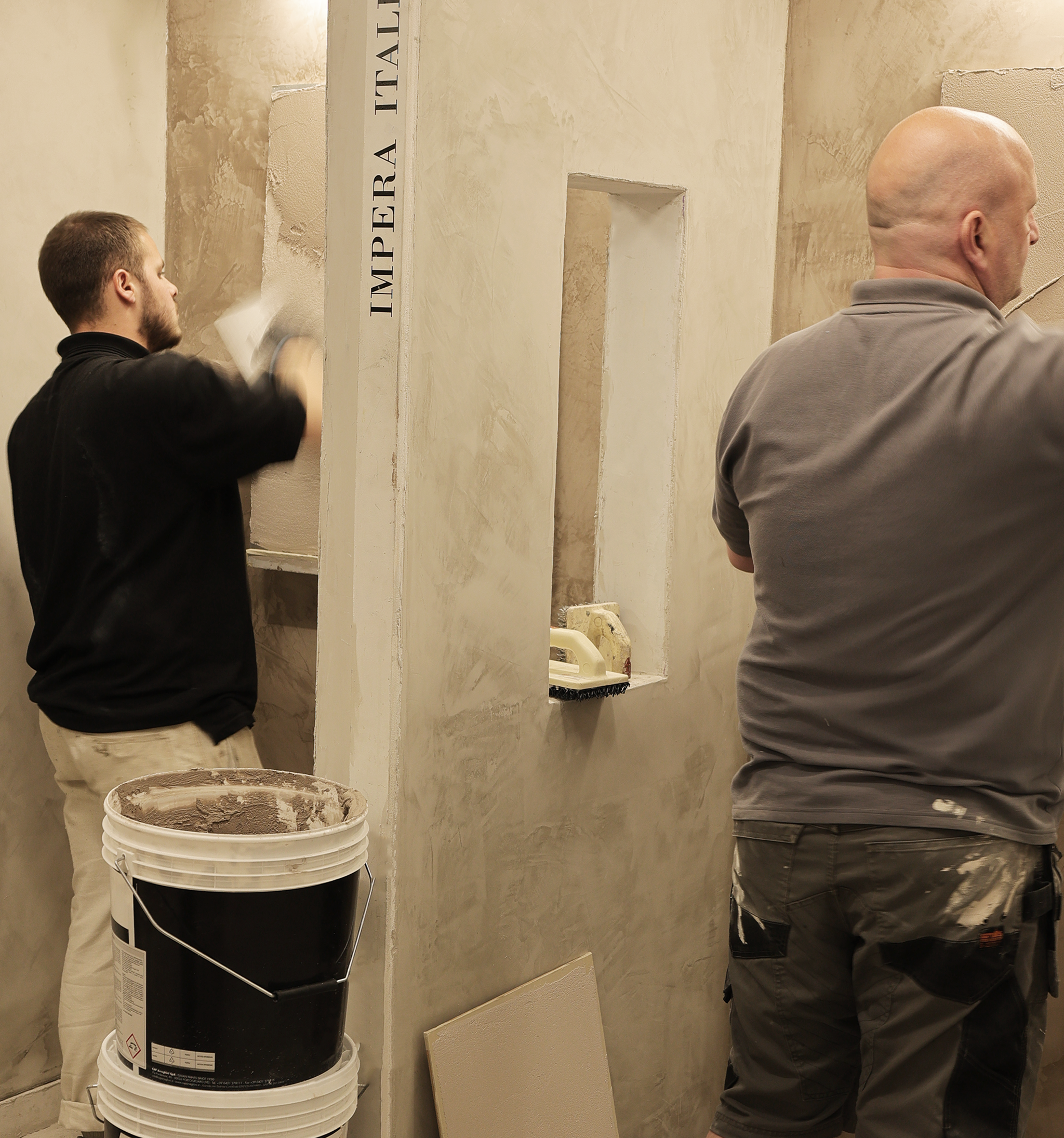
Want to get the best out of this material?
Anybody can put paint on a wall and chuck plaster onto their trowel. But creating art... That requires serious skill!
That is why we offer some of the most comprehensive training in the industry! Our success relies on applicators confidently carrying out jobs. That is why we work hard to make sure that we pass on our knowledge of the industry, to inspire the next generation of artists. This could be you!
Continuo Microcement Sample Kit
Regular price £62.40Continuo Microcement System for 5sqm
Regular price £288.00Continuo Microcement System for 10sqm
Regular price £360.00Round Shower Tray Designed For Microcement Application
Regular price From £432.00Linear Shower Tray (600mm Rectangular Grid) Designed For Microcement Application
Regular price From £720.00Linear Shower Tray (800mm Rectangular Grid) Designed For Microcement Application
Regular price From £720.00Allover System For Walls (Textured Finish) 10sqm Kit Suitable For Walls Only
Regular price £432.00Allover System With Anticrack For Floors (Textured Finish) 10sqm Kit Suitable For Floors & Walls
Regular price £540.00
Showing 8 of 8 results
Articles:


